ข้อมูลการปฏิบัติที่ดีที่สุด (Best Practice) ของกรุงโซล สาธารณรัฐเกาหลี
การฟื้นฟูเมืองของกรุงโซล
การบูรณะคลองชองกเยชอนและการฟื้นฟูย่านใจกลางเมือง
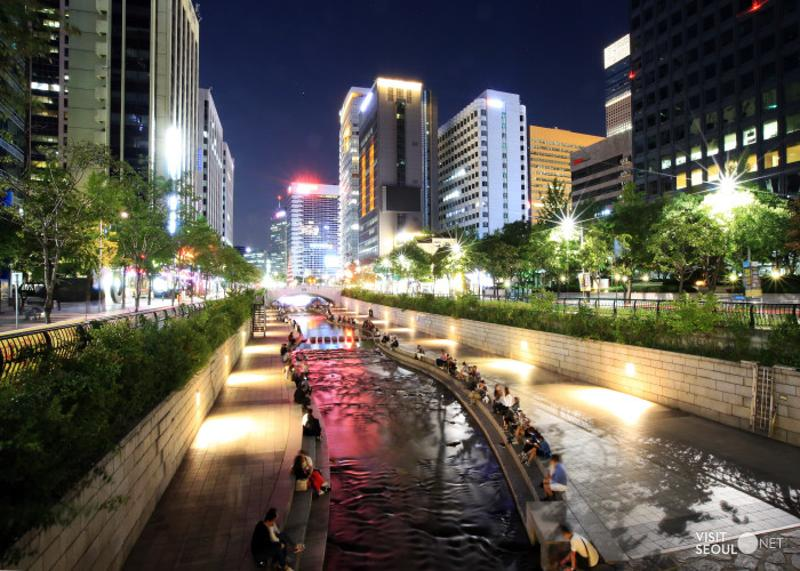
ภาพโดย visitseoul.net
- ปัญหาและการปรับเปลี่ยนกรอบความคิด
ความซบเซาในย่านใจกลางกรุงโซล
ย่านใจกลางกรุงโซลรวมถึงพื้นที่รอบคลองชองกเยชอน (Cheonggyecheon) เคยเป็นศูนย์กลางเศรษฐกิจเมืองที่เต็มไปด้วยธุรกิจจำนวนมาก ถนนที่สร้างบนคลองชองกเยชอนและทางยกระดับ
เคยเป็นเส้นทางหลักของการสัญจรภายในเมือง พื้นที่แห่งนี้เคยเป็นพื้นที่หลักในการพัฒนาเศรษฐกิจเมืองด้วยการสร้างงานและกระตุ้นกิจกรรมที่ก่อให้เกิดความคิดสร้างสรรค์และนวัตกรรมใหม่ อย่างไรก็ตาม ตั้งแต่คริสต์ศตวรรษที่ 1980 โครงสร้างทางเศรษฐกิจของกรุงโซลได้เปลี่ยนแปลงจากอุตสาหกรรมเบาขนาดเล็ก เป็นอุตสาหกรรมการผลิตและการบริการ ย่านใจกลางเมืองที่เคยเป็นพื้นที่ขนาดเล็กบนถนนแคบ ๆ ต้องรองรับอุตสาหกรรมแบบใหม่ การพัฒนาจึงไม่ง่ายนักเนื่องจากราคาที่ดินสูงเป็นทุนเดิม เมื่อการพัฒนาและการก่อสร้างใหม่เกิดการชะลอตัว ย่านใจกลางเมืองจึงเริ่มล้าสมัย ด้วยราคาที่ดินที่ไม่มีทีท่าจะลดลงประกอบกับ ภูมิทัศน์ที่เสื่อมโทรมและคุณภาพชีวิตที่ถดถอย ผู้คนและธุรกิจต่าง ๆ จึงย้ายออกจากพื้นที่ ส่งผลให้โครงสร้างของเมืองเปลี่ยนแปลงด้วย ในอดีตย่านใจกลางเมืองเคยเป็นศูนย์กลางของทุกสิ่งทุกอย่าง ทั้งที่อยู่อาศัย
การทำงาน และการผลิต ได้กลายเป็นเขตศูนย์กลางธุรกิจซึ่งมุ่งเน้นการผลิตและธุรกิจมากขึ้นตามการพัฒนาของเมือง ย่านที่อยู่อาศัยได้ย้ายไปในพื้นที่ชานเมืองเนื่องจากมีความสะดวกสบาย ความเงียบสงบ ความสะอาด และความเหมาะสมในการศึกษาของเยาวชนมากกว่า โครงสร้างเมืองของกรุงโซลมีการเปลี่ยนแปลงอย่างต่อเนื่องตามการรวมอำนาจแบบหลายศูนย์กลาง (multi-centralization) ด้วยการเติบโตของสำนักงานย่อยและการแข่งขันที่เกิดขึ้นจากใช้ประโยชน์จากที่ดินรูปแบบต่าง ๆ เมื่อย่านใจกลางเมืองไม่สามารถปรับตัวตามการเปลี่ยนแปลงได้ ประชาชนและธุรกิจต่าง ๆ จึงทยอยย้ายออกมาจากพื้นที่
ใน ค.ศ. 2000 จำนวนธุรกิจที่ตั้งอยู่ในย่านใจกลางเมืองมีจำนวน 77,000 ราย ลดลงจาก
ปี 1991 ซึ่งมีจำนวน 100,200 ราย คิดเป็นร้อยละ 24.1 ซึ่งสูงมากเมื่อเทียบกับจำนวนธุรกิจในกรุงโซลทั้งหมดที่เพิ่มขึ้นถึงร้อยละ 24.6 ในช่วงเดียวกัน นอกจากนี้ จำนวนธุรกิจที่ตั้งอยู่ในย่านใจกลางเมืองเมื่อเทียบกับธุรกิจทั้งหมดในกรุงโซลได้ลดลงจากร้อยละ 17.7 ในปี 1991 เป็นร้อยละ 10.8 ในปี 2000 แรงงานในย่านใจกลางเมืองในปี 2000 มีจำนวน 400,000 คน ลดลงจากปี 1991 ร้อยละ 54.3 และเมื่อเทียบกับจำนวนแรงงานในกรุงโซลทั้งหมดแล้ว ในปี 1991 มีการลดลงจากร้อยละ 18.9 เหลือร้อยละ 11.7
ในปี 2000

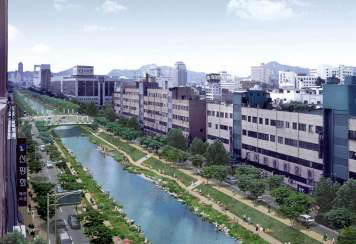
สภาพก่อนและหลังการบูรณะคลองชอกเยชอน ภาพโดย Dr. In-Keun LEE
ปัญหาความปลอดภัยของทางยกระดับ
ปัญหาความปลอดภัยเป็นจุดเริ่มต้นของการหารือเรื่องการบูรณะคลองชองกเยชอน ตั้งแต่ช่วงคริสต์ศตวรรษที่ 1990 โครงสร้างถนนและทางยกระดับเหนือคลองชองกเยชอนมีความเสื่อมโทรมก่อให้เกิดความเสี่ยงด้านความปลอดภัย การตรวจสอบในเชิงลึกโดยสภาวิศวกรโยธาเกาหลี (Korean Society of Civil Engineers) ในช่วงปี 1991 – 1992 พบการสึกกร่อนของโครงสร้างเหล็กภายในทางยกระดับและความบกพร่องทางโครงสร้างบริเวณแผ่นถนนคอนกรีตด้านบน จึงดำเนินการซ่อมแซมเป็นระยะทาง 2 กิโลเมตร ถนนเหนือคลองชองกเยชอนซึ่งใช้งานมา 30 ปี ใช้งบประมาณในการบำรุงรักษาและซ่อมแซมจำนวนมาก ต่อมาการตรวจสอบเชิงลึกในช่วงเดือนสิงหาคม 2000 – พฤษภาคม 2001 ยังคงพบปัญหารอยร้าว พื้นถนนหลุดร่อน รวมถึงคานคอนกรีตเสื่อมสภาพทำให้ความสามารถในการรับน้ำหนักไม่เพียงพอ จึงต้องดำเนินการก่อสร้างใหม่ทั้งหมดซึ่งจะใช้เวลา 3 ปี และมีประมาณการค่าใช้จ่าย 93 ล้านวอน ต่อมาในปี 2001 กรุงโซลได้วางแผนทุบทำลายทางยกระดับเพื่อก่อสร้างใหม่ โดยจะเริ่มดำเนินการในเดือนสิงหาคม 2002
การเปลี่ยนแปลงจากการบำรุงรักษาทางยกระดับเป็นการบูรณะลำคลอง
ตั้งแต่คริสต์ศตวรรษที่ 1960 การพัฒนา การก่อสร้าง การผลิต และความมีประสิทธิภาพ ถือเป็นหลักการที่สำคัญลำดับต้น ๆ ของกรุงโซล อย่างไรก็ตาม คริสต์ศตวรรษที่ 1990 กระบวนทัศน์หรือกรอบความคิดเรื่องการวางผังเมืองได้เปลี่ยนแปลงไปโดยเน้นการให้ความสำคัญกับผู้คน ประวัติศาสตร์ ธรรมชาติ และสิ่งแวดล้อม เนื่องจากจิตสำนึกของประชาชนเปลี่ยนแปลงไปตามการพัฒนาเศรฐกิจเชิงสังคม การแสดงความคิดเห็นเรื่องเหตุผลความจำเป็นและความสำคัญของการบูรณะคลองชองกเยชอนได้เกิดขึ้นในวงกว้างตั้งแต่ช่วงปลายคริสต์ศตวรรษที่ 1990 การบูรณะคลองกลายเป็นประเด็นสำคัญในการหาเสียงเลือกตั้งนายกเทศมนตรีในช่วงครึ่งแรกของปี 2002 โดยในช่วงนี้ทิศทางของแผนที่วางไว้ได้เปลี่ยนแปลงจากการสร้างทางยกระดับใหม่เป็นการบูรณะคลอง ซึ่งต้องเผชิญกับทางเลือกและการตัดสินใจมากมายระหว่างจุดมุ่งหมายในอุดมคติ เช่น ค่านิยมทางประวัติศาสตร์ ความเป็นมิตรกับสิ่งแวดล้อม การเพิ่มศักยภาพสูงสุดให้แต่ละภาคส่วน เป็นต้น กับข้อพิจารณาในทางปฏิบัติ เช่น งบประมาณ เวลา การเพิ่มศักยภาพสูงสุดในภาพรวม การลดความไม่สะดวกแก่ธุรกิจบริเวณใกล้เคียง การดำเนินการโดยแบ่งเป็นระยะ เป็นต้น
- การบูรณะคลองชองกเยชอน
ขอบเขตของการฟื้นฟูเมืองด้วยการบูรณะคลองชองกเยชอน
การบูรณะคลองชองกเยชอนด้วยแรงผลักดันของภาครัฐ และการฟื้นฟูเมืองด้วยแรงผลักดันของภาคเอกชน
โครงการมีวัตถุประสงค์เพื่อฟื้นฟูพื้นที่สาธารณะที่เสื่อมสภาพ สร้างพื้นที่ริมน้ำในเมือง ปรับปรุงสภาพแวดล้อม และฟื้นฟูคุณค่าทางประวัติศาสตร์ การดำเนินโครงการจะคืนชีวิตให้แก่เมืองโดยการดึงดูดประชากรให้เพิ่มมากขึ้นและเพิ่มกิจกรรมการประกอบธุรกิจ ซึ่งจะเพิ่มแรงผลักดันให้เกิดการเติบโตของเมืองและดึงดูดเงินลงทุนเอกชน ในขณะเดียวกัน การหารือได้รวมถึงการค้นหาแนวทางให้ภาครัฐและภาคเอกชนได้รับประโยชน์ร่วมกันควบคู่ไปกับการบรรลุเป้าหมายในการฟื้นฟูเมืองโดยภาคเอกชน นอกจากการวางเป้าหมายในระยะยาวแล้ว การกำหนดขอบเขตเฉพาะของโครงการยังเป็นความท้าทายอีกอย่างหนึ่ง แม้ว่าคลองชองกเยชอนจะเป็นพื้นที่สาธารณะ แต่ที่ดินโดยรอบนั้นครอบครองโดยเอกชน การรวมทรัพย์สินส่วนบุคคลเข้าเป็นส่วนหนึ่งของโครงการจะเป็นการสิ้นเปลืองงบประมาณอย่างมากและใช้เวลาดำเนินการในเรื่องต่าง ๆ อย่างยาวนาน ทั้งการปรับผังเมืองและการจ่ายเงินชดเชย กรุงโซลจึงตัดสินใจว่าจะบูรณะเฉพาะพื้นที่สาธารณะบริเวณถนนชองกเยโร (Cheonggyero) เพื่อให้แน่ใจว่าสามารถดำเนินโครงการได้จริง
ซึ่งภายใต้หลักการนี้ ภาครัฐและภาคเอกชนต่างผลัดกันมีบทบาทในการดำเนินโครงการ โดยกรุงโซลเริ่มดำเนินการด้วยการทุบทำลายถนนและทางยกระดับ สร้างพื้นที่ริมน้ำที่เป็นมิตรต่อสิ่งแวดล้อม และฟื้นฟูคุณค่าทางประวัติศาสตร์ของคลองโดยใช้งบประมาณของรัฐ การบูรณะจะส่งผลเป็นวงกว้างอย่างต่อเนื่อง ช่วยให้เกิดการฟื้นฟูย่านใจกลางเมืองและพื้นที่โดยรอบ ซึ่งจะดำเนินการร่วมกับภาคเอกชนในแนวทางที่ทั้งสองฝ่ายได้รับผลประโยชน์ร่วมกัน
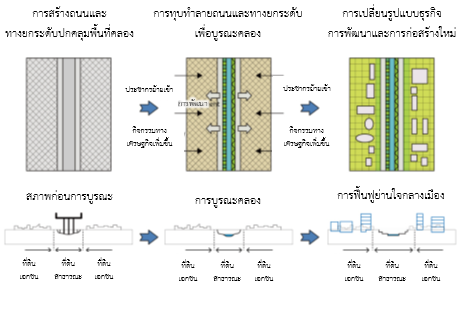
การบูรณะคลองชองกเยชอนเพื่อฟื้นฟูคุณค่าตามธรรมชาติของระบบนิเวศทางน้ำของกรุงโซล คลองชองกเยชอนเป็นคลองที่ทอดยาวผ่านย่านใจกลางเมืองของกรุงโซลและมีคลองสายย่อยจำนวนมาก กรุงโซลวางแผนระยะยาวในการฟื้นฟูระบบนิเวศน์ทางน้ำโดยการฟื้นฟูคลองสายย่อยต่าง ๆ ดังเช่นคลองจองฮักชอน (Junghakcheon) และคลองแพคอุนดงชอน (Baekundongcheon) ที่อยู่ในช่วงต้นน้ำ อย่างไรก็ตาม แผนการดังกล่าวยังไม่สามารถดำเนินการได้ในคราวเดียว จึงมีการกำหนดขอบเขตของโครงการให้อยู่ระหว่างถนนเซจงโน (Sejongno) กับบริเวณที่คลองชองกเยชอนบรรจบกับคลองจุงนังชอน (Jungnangcheon)
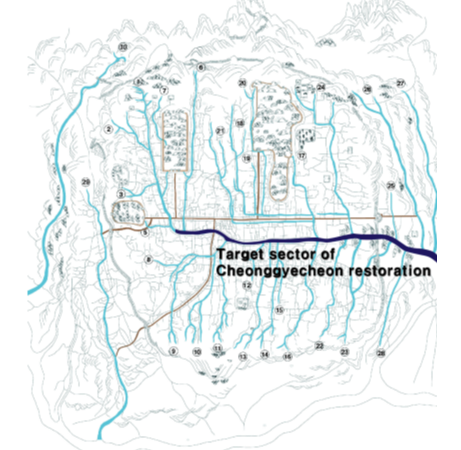
พื้นที่เป้าหมายของการบูรณะคลองชองกเยชอน
ประเด็นที่เกิดขึ้นระหว่างการพัฒนาแผนการดำเนินงานเฉพาะด้าน
ถึงแม้ว่าประชาชนจะเห็นด้วยกับความจำเป็นในการบูรณะคลองชองกเยชอน แต่ก็มีความคิดเห็นที่หลากหลายต่อสภาพคลองที่เสร็จสมบูรณ์ บางส่วนให้ความสำคัญกับคุณค่าทางประวัติศาสตร์ ในขณะที่บางส่วนต้องการลดความไม่สะดวกที่เกิดขึ้นในบริเวณใกล้เคียงจากการก่อสร้างให้ได้มากที่สุด นอกจากนี้
ยังต้องพิจารณาปัญหาในการดำเนินโครงการ เช่น ระยะเวลาและงบประมาณในการก่อสร้าง เป็นต้น รวมถึงปัญหาสำคัญดังเช่นการคมนาคมและการป้องกันน้ำท่วม การตัดสินใจในขั้นต่อไปจะต้องคำนึงถึงงบประมาณ ช่วงเวลาในการดำเนินการ ขอบเขตโครงการ แหล่งน้ำ และเทคนิคการก่อสร้างในระดับต่าง ๆ ก่อให้เกิดปัญหามากมายระหว่างขั้นตอนการวางแผนการดำเนินงานเนื่องปัจจัยต่าง ๆ ที่ต้องพิจารณามีความขัดแย้งกัน กรุงโซลจึงแต่งตั้งคณะกรรมการประชาชนเพื่อรวบรวมความคิดเห็นต่าง ๆ ของประชาชน ผู้เชี่ยวชาญ และผู้มีส่วนเกี่ยวข้อง จากนั้นนำไปบรรจุในแผนการดำเนินโครงการ แม้ว่างโครงการนี้จะเป็นโครงการระยะยาวซึ่งต้องวางแนวทางการดำเนินงานในระยะยาวด้วย กรุงโซลต้องสรุปแนวทางแก้ไขปัญหาที่มีประสิทธิภาพมากที่สุดอย่างรวดเร็วเพื่อให้โครงการเดินหน้าต่อไปได้ หลังจากการหารือหลายครั้ง แผนการดำเนินโครงการบูรณะคลองชองกเยชอนเสร็จสมบูรณ์เมื่อเดือนมิถุนายน 2003 อย่างไรก็ตาม ยังคงมีการหารือเพื่อปรับแก้ไขโครงการและพัฒนาความคิดริเริ่มระยะยาวในอนาคตต่อไป
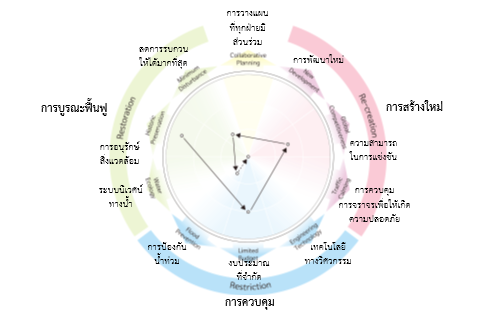
การกำหนดแผนการบูรณะฟื้นฟูเพื่อแก้ไขปัญหาอย่างมีประสิทธิภาพด้วยการจัดลำดับความสำคัญ
องค์ประกอบสำคัญของแผนการบูรณะคลองชองกเยชอน
การบูรณะฟื้นฟูต้องพิจารณาถึงปัจจัยต่าง ๆ ของคลองชองกเยชอน ทั้งในด้านประวัติศาสตร์ โครงสร้าง และประโยชน์การใช้สอย ประชาชนมีความกังวลในประเด็นต่าง ๆ ซึ่งรวมถึงการบูรณะวัตถุทางประวัติศาสตร์ที่หลงเหลืออยู่ ดังเช่นสะพานเก่าแก่หรือสิ่งก่อสร้างที่ทำจากหิน คลองที่เสร็จสมบูรณ์จะต้องมีความจุเพียงพอเพื่อรองรับน้ำท่วมเนื่องจากฝนที่ตกนอกฤดูกาลซึ่งเป็นผลกระทบจากการเปลี่ยนแปลงสภาพอากาศ นอกจากนี้ ยังมีความจำเป็นในการรักษาบทบาทเดิมของคลองในการเป็นช่องทางการคมนาคมและทางระบายน้ำเสีย แต่สิ่งที่สำคัญที่สุดคือการพัฒนาสิ่งแวดล้อมตามธรรมชาติเพื่อเป็นแรงบันดาลใจที่ดีที่สุดแก่ประชาชน ซึ่งมีความสำคัญเทียบเท่ากับการรักษาปริมาณน้ำในคลองที่ทำได้ยาก
■ การฟื้นฟูคุณค่าทางประวัติศาสตร์
การฟื้นฟูคุณค่าทางประวัติศาสตร์มีความสำคัญในแง่ของการแสดงให้เห็นถึงความคุ้มค่าของการดำเนินโครงการและเพื่อให้มั่นใจว่าจะได้รับการสนับสนุนจาประชาชน ดังนั้น กรุงโซลจึงยึดถือหลักการ
ในการอนุรักษ์มรดกของชาติที่ค้นพบระหว่างการก่อสร้างเป็นสำคัญ แต่ในความเป็นจริงแล้วหลักการนี้มีความสำคัญน้อยกว่าความปลอดภัยของประชาชน กรุงโซลจึงบูรณะคลองให้คืนสภาพเดิมให้ได้มากที่สุดโดยคำนึงถึงความปลอดภัยของประชาชนจากน้ำท่วมและความเสี่ยงอื่น ๆ ก่อน อย่างไรก็ตาม สมาชิกบางส่วน
ของคณะกรรมการประชาชนและสมาคมประชาชนบางแห่งยังยืนยันให้บูรณะคลองให้กลับสู่สภาพเดิมอย่างสมบูรณ์ ความเห็นที่แตกต่างนี้เริ่มเด่นชัดขึ้นในระหว่างการก่อสร้างจริง ข้อกังวลที่เกิดขึ้นระหว่างการดำเนินการ ทั้งการป้องกันน้ำท่วม การคมนาคม และการเจรจาต่อรองกับธุรกิจบริเวณใกล้เคียง บางส่วนส่งผลให้ไม่สามารถดำเนินการควบคู่ไปกับการอนุรักษ์สิ่งก่อสร้างทางประวัติศาสตร์ได้ หนึ่งในปัญหาที่ใหญ่ที่สุดคือการบูรณะสะพานควางทงกโย (Gwangtonggyo Bridge) ซึ่งมีการยืนยันให้ฟื้นฟูกลับสู่สภาพเดิม แต่การดำเนินการจะต้องมีการลงทุนเพิ้มขึ้น โดยจะต้องมีช่วงความยาวแนวขวางของสะพานและช่องทางระบายน้ำ
ที่เพียงพอ และจะต้องซื้อที่ดินบริเวณรอบสะพานจากเอกชนซึ่งในทางปฏิบัติไม่สามารถทำได้ หากมีช่องทางระบายน้ำไม่เพียงพออาจนำไปสู่ปัญหาด้านความปลอดภัยและการป้องกันน้ำท่วม กรุงโซลจึงตัดสินใจสร้างสะพานกวางทงแห่งใหม่ซึ่งห่างจากที่ตั้งเดิมขึ้นไป 150 เมตร โดยหวังว่าจะดำเนินการบูรณะสะพานในที่ตั้งเดิมเมื่อปัจจัยแวดล้อมมีความพร้อมมากขึ้นในอนาคต
การเปรียบเทียบเหตุผลการบูรณะสะพานควางทงกโย
|
สถานะปัจจุบัน
|
การบูรณะสู่สภาพเดิม
|
การสร้างใหม่
|
|
- ยาว 12 เมตร กว้าง 16 เมตร
|
- ช่องทางระบายน้ำไม่เพียงพอ (เสี่ยงต่อน้ำท่วม)
- ต้องปรับโครงสร้างเพิ่มเติมบริเวณเสาสะพานที่เตี้ยเกินไป เพื่อป้องกันน้ำท่วม
- การรักษาสภาพเดิมเป็นไปได้ยากเนื่องจากการโดนแสงแดด แรงสั่นสะเทือนจากยานพาหนะ มลพิษ และความเสี่ยงต่อ
น้ำท่วม
- ต้องลดขนาดถนนนัมแดมุนลงครึ่งหนึ่ง (จาก 8 เลน เหลือ 4 เลน)
|
- ย้ายที่ตั้งและใช้เป็นสะพานสำหรับคนเดิน
- รักษารูปร่างเดิมโดยปรับโครงสร้างบางส่วน
- หลีกเลี่ยงน้ำท่วมโดยออกแบบช่องทางระบายน้ำใหม่
- ไม่ต้องลดขนาดถนนนัมแดมุน
* ในอนาคตสามารถบูรณะสะพานในรูปแบบและที่ตั้งเดิมได้เมื่อปัจจัยแวดล้อมมีความพร้อมมากขึ้น
|

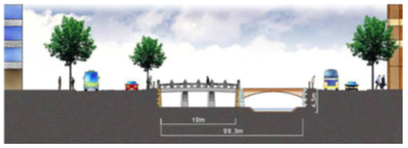
ที่ตั้งเดิม ที่ตั้งใหม่ และสะพานควางทงกโยที่บูรณะใหม่
การบูรณะสะพานซูพโยกโย (Supyogyo Bridge) ให้กลับสู่สภาพเดิมประสบปัญหาคล้ายคลึงกัน โดยคณะกรรมการมรดกทางวัฒนธรรมแห่งกรุงโซล (Cultural Heritage Committee of Seoul) มีมติให้ย้ายสะพานไปที่สวนสาธารณะจังชุงดัน (Jangchungdan Park) เพื่อหลีกเลี่ยงการเสื่อมสภาพของโครงสร้างหินดั้งเดิม โดยสะพานมีความยาว 27.5 เมตร ซึ่งยาวกว่าความกว้างของคลองที่บูรณะใหม่บริเวณที่สะพานตั้งอยู่เดิม (22 เมตร) ในการย้ายกลับมาที่ตั้งเดิมให้อยู่ในสภาพสมบูรณ์นั้น กรุงโซลจะต้องเวนคืนที่ดินเอกชนบริเวณข้างเคียง ส่งผลให้ต้องขยายระยะเวลาการก่อสร้างและก่อให้เกิดความไม่สะดวกแก่ธุรกิจโดยรอบ ดังนั้น กรุงโซลจึงตัดสินใจเลื่อนการบูรณะสะพานซูพโยจนกว่าปัจจัยแวดล้อมต่าง ๆ จะมีความเหมาะสม

■ มาตรการป้องกันน้ำท่วมและความปลอดภัย
ถึงแม้ว่าการบูรณะคลองชองกเยชอนจะมีจุดเริ่มต้นจากการฟื้นฟูค่านิยมทางประวัติศาสตร์และสิ่งแวดล้อม แต่เมื่อเริ่มดำเนินโครงการแล้วประเด็นความปลอดภัยซึ่งรวมถึงการป้องกันน้ำท่วมจะต้องมาก่อน กรุงโซลคาดการณ์ว่าจะเกิดน้ำท่วมในทุก ๆ 200 ปี โดยอ้างอิงจากการคาดการณ์การเกิดน้ำท่วมทุก ๆ 50 ปี ในคลองชั้นสองอื่น ๆ ของเมือง กรุงโซลจึงตระเตรียมคูคลองให้มีความจุเพียงพอในการรองรับฝนตกหนัก และขุดพื้นที่ภายใต้ตลิ่งทั้งสองฝั่งคลองเพื่อเป็นช่องทางระบายน้ำที่มีความจุเพียงพอเพื่อความปลอดภัยของประชาชน
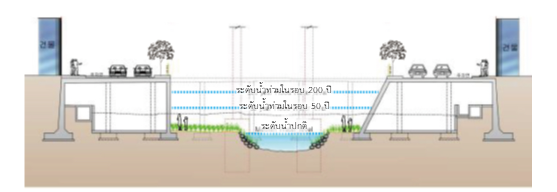
ภาพคลองชองกเยชอนตามแนวขวาง และประมาณการระดับน้ำท่วม
■ การบำบัดน้ำเสีย
แต่เดิมนั้นน้ำเสียจากย่านใจกลางกรุงโซลจะระบายลงคลองชองกเยชอน ส่งผลให้มีท่อระบายน้ำจำนวนมากฝังอยู่บริเวณใกล้เคียง จึงมีความจำเป็นต้องค้นหาวิธีการบำบัดน้ำเสียให้ได้ก่อนเริ่มการบูรณะคลองชองกเยชอน เนื่องจากระบบท่อระบายน้ำเสียมักสร้างรวมกับระบบรวบรวมน้ำฝนก่อนจะระบายลงคลอง การแยกน้ำเสียออกจากน้ำฝนจึงแทบเป็นไปไม่ได้ อีกทั้งน้ำฝนที่ไหลลงสู่คลองชองกเยชอนนั้นมีความสกปรกสูงจึงไม่ควรแยกน้ำทั้งสองประเภทออกจากกัน ดังนั้น กรุงโซลจึงใช้ระบบกล่องคู่ (double-box system) โดยบำบัดน้ำเสียในระบบร่วม และจะระบายน้ำฝนแรกที่มีความสกปรกสูงลงสู่ท่อแยกเพื่อเข้าสู่ระบบบำบัดน้ำเสียต่อไปโดยไม่ไหลลงสู่คลอง
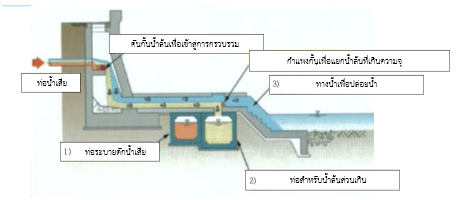
ระบบบำบัดน้ำเสียแบบกล่องคู่ (Double-box sewage treatment system)
■ ปริมาณและคุณภาพน้ำ
ในอดีตคลองชองกเยชอนเป็นคลองที่มีน้ำน้อยและไม่แน่นอน การสูบน้ำจากแหล่งน้ำใกล้เคียงทำได้ยากเพราะระดับน้ำลดลงเนื่องจากการพัฒนาของเมือง ประกอบกับการไม่มีพื้นที่ลุ่มน้ำบริเวณต้นน้ำ จึงต้องอาศัยน้ำจากแหล่งอื่นเพื่อรักษาระดับน้ำ ดังเช่นน้ำจากแม่น้ำฮัน (Han River) และน้ำบาดาล
จากสถานีรถไฟใต้ดินใกล้เคียง บริษัท โคเรีย วอเตอร์ รีซอร์สเซส คอร์เปอเรชั่น (Korea Water Resources Corporation) เคยพยายามเรียกเก็บภาษีสูบน้ำจากแม่น้ำฮันจากกรุงโซล แต่สุดท้ายแล้วได้ให้ส่วนลดร้อยละ 100 เนื่องจากการใช้น้ำเป็นไปเพื่อประโยชน์สาธารณะ ในส่วนของคุณภาพน้ำ เมื่อพิจารณาจากเงื่อนไขและค่าใช้จ่ายต่าง ๆ แล้ว จึงใช้การบำบัดน้ำเสียเป็นการบำบัดขั้นที่สอง
การแก้ปัญหาทางเทคนิค: ระยะเวลาการก่อสร้างอันสั้น งบประมาณจำกัด และการรีไซเคิลขยะ
เมื่อปี 2001 มีการประกาศทุบทำลายบริเวณคลองชองกเยชอนและบูรณะใหม่นับตั้งแต่ปี 2002 เป็นเวลาไม่เกิน 3 ปี ในช่วงเวลานี้จึงเกิดความไม่สะดวกแก่ผู้ค้าในบริเวณใกล้เคียงอย่างหลีกเลี่ยงไม่ได้ เกิดการร้องเรียนให้ลดระยะเวลาการก่อสร้างให้สั้นที่สุด กรุงโซลจึงให้ความสำคัญกับประเด็นนี้เป็นลำดับต้น ๆ เพื่อการลดเวลาการก่อสร้างควบคู่กับการน้อมรับความความคิดสร้างสรรค์อันหลากหลายจากภาคเอกชน สัญญาจ้างของโครงการจึงดำเนินการในระบบ “ออกแบบ-ก่อสร้างแบบเร่งรัด (fast-track design-build)” โดยคัดเลือกผู้รับจ้างจากบริษัทที่เข้าร่วมการประมูลโดยพิจารณาข้อเสนอที่อ้างอิงจากแนวทางการออกแบบขั้นพื้นฐานโดยกรุงโซล เนื่องจากหน่วยงานของกรุงโซลจำนวน 3 หน่วยงาน เป็นผู้ออกแบบที่มีความแตกต่างกัน ในแต่ละพื้นที่ กรุงโซลจึงต้องเข้ามามีส่วนร่วมในการทำงานเพื่อให้โครงการมีความต่อเนื่องและแก้ปัญหาที่เกิดขึ้น ดังเช่นความแตกต่างระหว่างแนวคิดหรือความผิดพลาดในการเชื่อมต่อท่อระบายน้ำในต่างพื้นที่เข้าด้วยกัน
การก่อสร้างเริ่มขึ้นในเดือนกรกฎาคม 2003 การทุบทำลายโครงสร้างส่วนใหญ่เสร็จสิ้นในเดือนตุลาคม โดยมีการพัฒนารูปแบบในรายละเอียดสำหรับการก่อสร้างคลองควบคู่ไปด้วย การก่อสร้างเสร็จสมบูรณ์ในช่วงต้นปี 2005 จากนั้นมีการทดสอบการใช้งานจริงหลายครั้งในช่วงฤดูฝน และโครงการเสร็จสมบูรณ์ในเดือนกันยายน 2005 ใช้เวลาทั้งสิ้น 27 เดือน ขยะที่เกิดขึ้นระหว่างการก่อสร้างร้อยละ 96
ผ่านการรีไซเคิลกลับมาใช้ใหม่
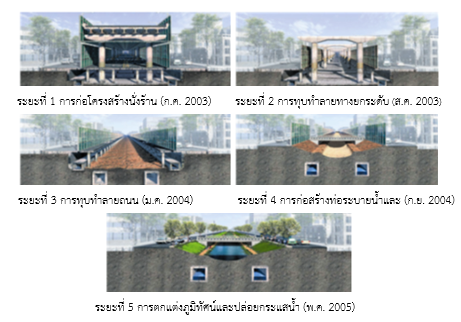
การบูรณะคลองชองกเยชอนในระยะต่าง ๆ
- การฟื้นฟูย่านใจกลางเมือง
เพื่อเป็นการฟื้นฟูย่านใจกลางเมืองโดยอาศัยศักยภาพในการพัฒนาพี่เพิ่มขึ้นจากการบูรณะคลองชองกเยชอน กรุงโซลได้ปรับปรุง “แผนบริหารจัดการย่านใจกลางเมือง (Downtown Management Plan)” ซึ่งเป็นผังเมืองเดิมที่ร่างขึ้นใน ค.ศ. 2000 และเปลี่ยนชื่อใหม่เป็น “แผนพัฒนาย่านใจกลางเมือง (Downtown Development Plan)” เพื่อเพิ่มนัยของความมีประสิทธิภาพ
แผนการฟื้นฟูย่านใจกลางเมือง
นอกเหนือจากการบูรณะคลองชองกเยชอนแล้ว กรุงโซลตั้งเป้าหมายว่าจะหลีกเลี่ยงการพัฒนาที่เกินกว่าความจำเป็น และสร้างสถานที่เพื่อประสบการณ์ทางวัฒนธรรม ธุรกิจ การช็อปปิ้ง และกิจกรรมการท่องเที่ยวรอบ ๆ คลองชองกเยอชอน เพื่อรักษาสภาพเศรษฐกิจของพื้นที่ รวมถึงสร้างจุดหมายปลายทางให้นักเที่ยวเที่ยวได้เยี่ยมชมมรดกทางประวัติศาสตร์และวัฒนธรรมรอบ ๆ คลองชองกเยชอน โครงการนี้นำไปสู่การร่างแผนการจัดการเมืองเพื่อควบคุมความสูงอาคาร อัตราส่วนของพื้นที่อาคารปกคลุมดินต่อพื้นที่แปลงที่ดิน (building coverage ratio) ความหนาแน่นในการพัฒนา และมาตรฐานที่จอดรถ แผนการพัฒนาย่านใจกลางเมือง ค.ศ. 2004 แบ่งพื้นที่บริเวณคลองชองกเยชอนออกเป็น 22 ส่วน และจัดประเภทเป็นพื้นที่อนุรักษ์พิเศษ พื้นที่พัฒนาใหม่ พื้นที่ฟื้นฟูตามความสมัครใจ และพื้นที่จัดระเบียบใหม่ทั้งหมด ตามลักษณะเฉพาะของพื้นที่ รูปแบบการใช้ที่ดิน และลักษณะทางประวัติศาสตร์ โดยพัฒนาพื้นที่พัฒนาใหม่และพื้นที่จัดระเบียบใหม่ทั้งหมดอย่างจริงจังเพื่อเสริมสร้างลักษณะเฉพาะของพื้นที่ และพัฒนาพื้นที่อนุรักษ์พิเศษและพื้นที่ฟื้นฟูตามความสมัครใจเพื่อรักษาอัตลักษณ์เดิม พร้อมกับปรับปรุงให้เค้ากับการเปลี่ยนแปลงตามยุคสมัย
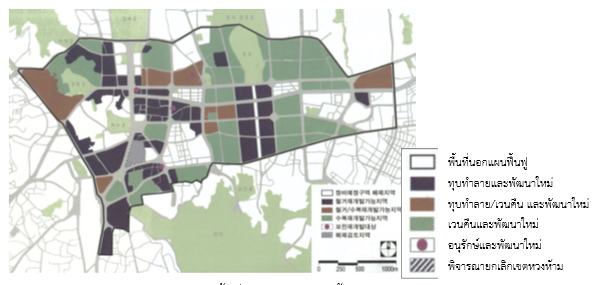
พื้นที่และแนวทางการฟื้นฟูเมือง
ยกตัวอย่างเช่น การกำหนดย่านควานชอลดง (Gwancheol-dong) เป็นพื้นที่อนุรักษ์
โดยจำกัดโครงการพัฒนาขนาดใหญ่ด้วยการกำหนดขนาดพื้นที่สูงสุดสำหรับการพัฒนาร่วมเพื่อรักษาเอกลักษณ์ของพื้นที่ และสนับสนุนให้อาคารขนาดเล็กใช้พื้นที่เพื่อการพาณิชย์เพื่อฟื้นฟูสภาพพื้นที่ริมทาง
และสร้างสิ่งแวดล้อมที่เป็นมิตรต่อคนเดินถนน

แนวทางการปรับปรุงและความท้าทายในย่านความชอลดง (ทางเหนือของคลองชองกเยชอน)
ย่านซัมกัคดง (Samgak-dong) กำหนดให้เป็นพื้นที่พัฒนาใหม่ มีการรวมอาคารเล็ก ๆ จำนวนหนึ่งและพัฒนาใหม่เป็นอาคารขนาดใหญ่เพื่อสร้างพื้นที่สาธารณะสำหรับประชาชนริมคลอง ทั้งนี้
มีการอนุรักษ์อาคารทางประวัติศาสตร์และคลองสายย่อยของคลองชองกเยชอนที่หลงเหลืออยู่เอาไว้
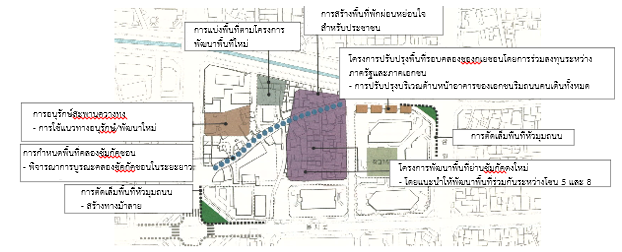
แนวทางและการพัฒนาใหม่และความท้าทายในย่านซัมกัคดง (ทางใต้ของคลองชองกเยชอน)
การักษาสินค้าสาธารณะบริเวณใกล้เคียง
ในมุมมองของการบูรณะ นอกจากบริเวณถนนชองกเยชอนแล้ว ปัญหาที่ใหญ่ที่สุดของรูปแบบการใช้พื้นที่รอบคลองชองกเยชอนคือการขาดแคลนพื้นที่สีเขียวและพื้นที่สาธารณะเพื่อให้ประชาชนเดินเล่นและพักผ่อนหย่อนใจโดยสิ้นเชิง ระดับความสูงของพื้นดินและลำคลองมีความแตกต่างกันอย่างมากเพราะการป้องกันน้ำท่วม และลำคลองยังแคบเกินกว่าที่จะทำพื้นที่ลาดเอียงที่มีความชันเหมาะสมเพื่อเชื่อมต่อกับระดับพื้นดินได้ นอกจากนี้ การทำให้คลองชองกเยชอนมีโค้งน้ำอย่างเป็นธรรมชาติในระยะยาวจะต้องอาศัยลำคลองที่กว้างขึ้น ในการนี้ กรุงโซลจะต้องซื้อที่ดินที่เป็นทรัพย์สินของเอกชนในบริเวณใกล้เคียง ซึ่งจะมีค่าใช้จ่ายสูงและมีขั้นตอนที่ยาวนาน อีกวิธีการหนึ่งในการป้องกันการเสียผลประโยชน์ของภาคเอกชนและสามารถได้มาซึ่งพื้นที่สาธาณะคือการเจรจาต่อรอง เมื่อเจ้าของที่ดินมอบที่ดินส่วนหนึ่งเพื่อประโยชน์สาธารณะ รัฐจะตอบแทนโดยการอนุญาตให้สร้างอาคารได้สูงขึ้น กล่าวคือ กรุงโซลแลกพื้นที่สาธารณะในแนวราบกับการอนุญาตให้มีการสร้างอาคารในแนวดิ่งมากขึ้น
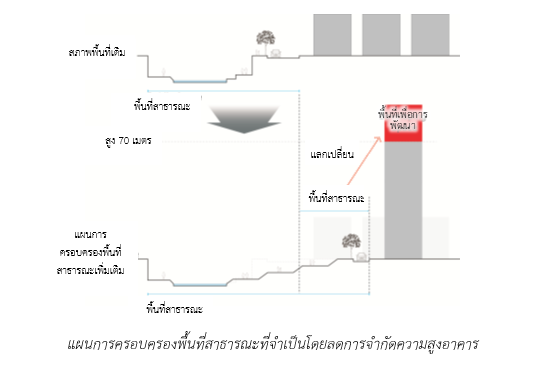
การลดกฎเกณฑ์การจำกัดความสูงอาคารอาจส่งผลกระทบต่อการควบคุมแนวอาคารสูง
ในย่านใจกลางเมือง แต่เป็นแนวปฏิบัติที่เป็นไปได้ในการครอบครองพื้นที่สาธารณะแลกกับการชดเชยให้แก่ภาคเอกชน การซื้อที่ดินแทบจะเป็นไปไม่ได้เนื่องจากภาระทางการเงินก้อนใหญ่ ขั้นตอนที่ยืดยาว และผลประโยชน์ทับซ้อนระหว่างเจ้าของที่ดินแปลงเล็ก ๆ จำนวนมาก ด้วยเหตุนี้ จึงมีการการลดกฎเกณฑ์การจำกัดความสูงอาคารรอบคลองชองกเยชอน การกำหนดความสูงของอาคารย่านใจกลางเมืองจึงเปลี่ยนแปลงไป โดยพื้นที่จำกัดความสูงไม่เกิน 50 เมตร ใน ค.ศ. 2000 ได้กลายเป็น 70 เมตรใน ค.ศ. 2004

การเปลี่ยนแปลงจุดสูงสุดของอาคารย่านใจกลางเมือง
ตามแผนบริหารจัดการ/พัฒนาย่านใจกลางเมือง ค.ศ. 2000 และ 2004
- ความสำเร็จตามโครงการ
การฟื้นฟูสภาพแวดล้อม ประกอบด้วยการสร้างช่องทางลม (wind corridor) การลดปรากฏการณ์เกาะความร้อน (Heat island effect) การปรับปรุงคุณภาพอากาศ และการฟื้นคืนสภาพแวดล้อมตามธรรมชาติ
มีรายงานระบุว่าการเปลี่ยนแปลงทางกายภาพและการลดความหนาแน่นของการจราจรในย่านคลองชองกเยชอนหลังจากการบูรณะในช่วงเวลาสั้น ๆ สามารถลดการกระจุกตัวของฝุ่นละออง (PM-10) ก๊าซไนโตรเจนออกไซด์ (NO2) สารประกอบอินทรีย์ระเหยง่าย (Volatile Organic Compounds: VOC) และมลพิษในอากาศอื่น ๆ อย่างมีนัยสำคัญ ปรากฏการณ์เกาะความร้อนในย่านใจกลางเมืองลดลง แม้ว่าอุณหภูมิในย่านคลองชองกเยชอนหลังการบูรณะจะสูงกว่าค่าเฉลี่ยของกรุงโซล 2.2 องศาเซลเซียส แต่ยังลดลงน้อยกว่าก่อนการบูรณะ 1.3 องศาเซลเซียส คิดเป็นร้อยละ 8 – 18 โดยอุณหภูมิ ณ จุดเขียว (green point) ภายในคลองต่ำกว่าบริเวณใกล้เคียง 0.9 องศาเซลเซียส เนื่องจากทางยกระดับที่บังลมหายไป มีการสร้างช่องทางลม และมีกระแสน้ำไหล จึงเป็นผลดีต่อสิ่งแวดล้อมรอบข้าง ระบบนิเวศน์ได้รับการฟื้นฟู มีจำนวนพันธุ์ปลา นก แมลง และพืชตามธรรมชาติเพิ่มขึ้น
|
|
ค.ศ. 2003
|
ค.ศ. 2004
|
ค.ศ. 2005 -2006
|
ค.ศ. 2010
|
ค.ศ. 2011 - 2012
|
|
พืช
|
121
|
136
|
160
|
510
|
365
|
|
สัตว์ป่า
|
9
|
18
|
19
|
37
|
48
|
|
แมลง
|
70
|
94
|
113
|
248
|
112
|
|
ปลา
|
7
|
7
|
21
|
25
|
23
|
|
สัตว์หน้าดินไม่มีกระดูกสันหลัง
|
28
|
28
|
27
|
29
|
44
|
|
แหล่งข้อมูล
|
กระทรวงวิทยาศาสตร์และเทคโนโลยี
(ค.ศ. 2007)
|
บริษัท Seoul Metropolitan Facilities Management Corporation (2010)
|
กรุงโซล (Seoul Metropolitan Government) (ค.ศ. 2012)
|
|
|
การควบคุมน้ำท่วม
คลองชองกเยชอนเป็นพื้นที่ราบระดับต่ำสุดในย่านใจกลางเมือง มีลุ่มน้ำกักเก็บน้ำฝนและมีตลิ่งที่มีความลาดชันน้อย จึงมีความเสี่ยงสูงในการเกิดน้ำท่วม ก่อนเริ่มการบูรณะได้เกิดน้ำเอ่อล้นตลิ่งติดต่อกัน 2 ปี ก่อให้เกิดความเสียหายในย่านใจกลางเมือง เนื่องจากกรุงโซลมีฝนตกหนักบ่อยครั้ง ช่องทางระบายน้ำของคลองชองกเยชอนหลังการบูรณะจึงออกแบบเพื่อรองรับน้ำท่วมซึ่งจะเกิดขึ้นทุก ๆ 200 ปี โดยการคาดการณ์ระบุว่าในช่วงก่อนการบูรณะพื้นที่ราบต่ำส่วนใหญ่รอบคลองชองกเยชอนประสบปัญหาน้ำท่วม โดยหลังการบูรณะยังไม่มีรายงานน้ำท่วมที่เกิดจากช่องทางระบายน้ำไม่เพียงพอ ซึ่งหมายความว่าสามารถป้องกันความเสียหายจากน้ำท่วมในพื้นที่โดยรอบได้

พื้นที่ก่อนการบูรณะที่ต่ำกว่าระดับน้ำท่วมในช่วงทุก ๆ 200 ปี
พื้นที่สาธารณะเพิ่มขึ้น สภาพแวดล้อมที่เป็นมิตรต่อคนเดินถนน ประชากรและนักท่องเที่ยวมาเยือนเพิ่มขึ้น
สถิติประชาการที่เข้ามาเยี่ยมชมพื้นที่คลองชองกเยชอนในช่วงวันธรรมดาและสุดสัปดาห์เพิ่มขึ้นอย่างเห็นได้ชัด โดยเพิ่มขึ้นในวันธรรมดามากกว่าสุดสัปดาห์ แสดงว่าประชาชนเข้ามาเยี่ยมชมในชีวิตประจำวันบ่อยครั้ง ผลสำรวจใน ค.ศ. 2013 ระบุว่า ผู้ตอบแบบสอบถามร้อยละ 89 ยังไม่มั่นใจหรือพึงพอใจกับทางเดินริมคลอง และมีความพึงพอใจโดยเฉพาะอย่างยิ่งกับความมีเอกลักษณ์ของสถานที่ อย่างไรก็ตาม มีความพึงพอใจน้อยกว่าในแง่ของการเข้าถึง เนื่องจากเส้นทางเดินที่เชื่อมระดับพื้นดินกับระดับลำคลองมีจำนวนไม่มากด้วยสาเหตุจากความแคบของลำคลอง ผลสำรวจใน ค.ศ. 2013 ระบุว่าร้อยละ 59.6 ของผู้ตอบแบบสอบถามเห็นว่าการบูรณะคลองชองกเยชอนมีประโยชน์มากที่สุดในการสร้างสถานที่พักผ่อนหย่อนใจ นอกจากนี้ คลองชองกเยชอนได้กลายเป็นสถานที่จัดกิจกรรมทางวัฒนธรรมที่หลากหลาย ระหว่างปี 2005 – 2007 มีการจัดกิจกรรมถึง 259 ครั้ง จึงเป็นสิ่งยืนยันว่าคลองชองกเยชอนเป็นสถานที่แห่งวัฒนธรรมและนันทนาการ
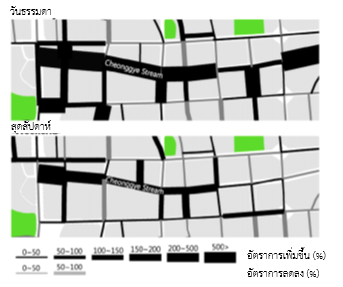
การเปลี่ยนแปลงปริมาณคนเดินถนนใน ค.ศ. 2003 และ 2006
การบูรณะคลองชองกเยชอนส่งผลให้สถานที่ท่องเที่ยวอื่น ๆ ย่านใจกลางเมือง ทั้งพระราชวังคยองบก (Gyeongbokgung) พระราชวังชางด๊อก (Changdeokgung) และตลาดมย็องดง (Myeongdong) เชื่อมต่อกันด้วยถนนคนเดิน เป็นการเพิ่มมูลค่าโดยรวมให้แก่พื้นที่สาธารณะในย่านใจกลางเมือง ส่งผลให้ย่านใจกลางกรุงโซลเป็นแหล่งท่องเที่ยวที่น่าดึงดูดใจมากยิ่งขึ้น หนังสือนำเที่ยวกรุงโซลเกือบทั้งหมดแนะนำให้วางแผนเยี่ยมชมคลองชองกเยชอน
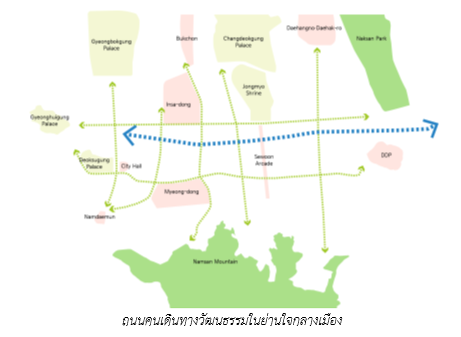
การฟื้นฟูย่านใจกลางเมืองเพื่อเพิ่มกิจกรรมทางเศรษฐกิจและเพิ่มมูลค่าอสังหาริมทรัพย์
คลองที่บูรณะแล้วได้เพิ่มศักยภาพในการพัฒนาของพื้นที่โดยรอบและเร่งให้พื้นที่ย่านใจกลางเมืองพัฒนาขึ้นใหม่อีกครั้ง แม้ว่าการเปลี่ยนแปลงการใช้ประโยชน์จากที่ดินในบริเวณต้นน้ำใกล้ย่านธุรกิจจะชะลอตัวระหว่างการบูรณะ แต่กลับพุ่งสูงขึ้นหลังการบูรณะเสร็จสิ้นตั้งแต่ ค.ศ. 2006 การใช้ประโยชน์จากที่ดินร้อยละ 74.4 เปลี่ยนแปลงไปเป็นการทำธุรกิจและสำนักงาน แสดงให้เห็นว่าเกิดการพัฒนาเพื่อวัตถุประสงค์ดังกล่าวเพิ่มขึ้นในย่านธุรกิจ โดยเฉพาะอย่างยิ่งมีการสร้างอาคารขนาดใหญ่หลังจากเสร็จสิ้นโครงการ
การแปลี่ยนแปลงจิตสำนึกของประชาชน
หนึ่งในความสำเร็จครั้งใหญ่ของการบูรณะคลองชองกเยชอนคือความตระหนักรู้เรื่องสิ่งแวดล้อมธรรมชาติของประชาชน ผู้คนมีความสนใจในสิ่งแวดล้อมธรรมชาติและต้องการให้คลองชองกเยชอน มีสภาพที่ดีขึ้นตั้งแต่ก่อนเริ่มโครงการ โดยหลังจากได้เห็นการฟื้นฟูสภาพลำคลองและสิ่งแวดล้อมแล้ว ผู้คนต่างเห็นคุณค่าของคลองชองกเยชอนมากขึ้น ผลสำรวจความต้องการของประชาชนในการจ่ายเงินแลกกับลำคลองธรรมชาติทั้งก่อนและหลังดำเนินโครงการระบุว่า มูลค่าทางเศรษฐกิจประจำปีของลำคลองธรรมชาติที่ประชาชนพึงพอใจเพิ่มขึ้นจาก 20,226 วอน เป็น 37,724 วอนต่อครัวเรือน การสำรวจยืนยันว่าชาวกรุงโซลเห็นคุณค่าของสิ่งแวดล้อมธรรมชาติมากขึ้นหลังจากได้เห็นคลองชองกเยชอนที่ฟื้นฟูสภาพแล้ว
- ระบบการดำเนินงานและงบประมาณ
ระบบการดำเนินงานแบบสามเหลี่ยม (Triangular implementation system)
โครงการบูรณะคลองชองกเยชอนแตกต่างจากแนวปฏิบัติในอดีตด้วยการสร้างระบบการดำเนินงานแบบสามเหลี่ยม ประกอบด้วยคณะกรรมการประชาชน สำนักงานใหญ่ และกลุ่มวิจัย ขอบข่ายโครงการเช่นนี้มีประโยชน์ในการดำเนินงานอย่างมีประสิทธิภาพ การรวบรวมความคิดเห็นของประชาชน และการประชาสัมพันธ์
คณะกรรมการประชาชนคลองชองกเยชอน (Cheonggyecheon Citizens' Committee) จัดตั้งขึ้นเพื่อเป็นช่องทางรวบรวมความคิดเห็นต่าง ๆ ของประชาชนอย่างเป็นทางการ มีความจำเป็นในการขับเคลื่อนโครงการไปข้างหน้าอย่างมีประสิทธิภาพ ประกอบด้วยผู้เชี่ยวชาญและตัวแทนประชาชนจากสาขาอาชีพต่าง ๆ ซึ่งรวมถึงผู้เชี่ยวชาญจากกลุ่มวิจัยเพื่อการคืนสภาพคลองชองกเยชอน (Cheonggyecheon Revival Research Group) มีหน้าที่หลักในการกำหนดทิศทางของโครงการ ได้รับมอบหมายให้ตรวจสอบและเฝ้าระวัง รวมถึงให้คำแนะนำโครงการ และมีพันธะทางกฎหมายในการประกาศใช้ข้อบัญญัติ นอกจากนี้ คณะกรรมการได้จัดการรับฟังความคิดเห็นประชาชนและการบรรยายสรุปหลายครั้งเพื่อรวบรวมความคิดเห็นที่หลากหลายของประชาชน สร้างฉันทามติภายในสังคม และกระตุ้นให้ประชาชนมีส่วนร่วมในโครงการ
สำนักงานใหญ่เพื่อการดำเนินโครงการมีความจำเป็นเช่นกัน โดยก่อตั้งเมื่อวันที่ 2 กรกฎาคม 2002 เดิมประกอบด้วย 3 หน่วยงานเพื่อบริหารจัดการ วางแผน และดำเนินโครงการ มีการปรับปรุงโครงสร้างอย่างต่อเนื่องเพื่อปรับตัวให้เข้ากับการดำเนินโครงการในระยะต่าง ๆ มีที่ตั้งอยู่ที่ศาลาว่าการกรุงโซลเพื่อการสื่อสารและดำเนินโครงการอย่างมีประสิทธิภาพ รวมถึงให้ความสำคัญกับการปฏิบัติงานในสถานที่จริงอย่างเคร่งครัด มีการประชุมประจำสัปดาห์ทุกวันเสาร์โดยมีนายกเทศมนตรีเป็นประธาน เจ้าหน้าที่ระดับสูงผู้รับผิดชอบโครงการจะเข้าร่วมการประชุมเพื่อหารือประเด็นสำคัญและตัดสินใจอย่างรวดเร็ว การประชุมนี้จึงสามารถแก้ปัญหาที่อาจเกิดขึ้นในองค์กรและส่งผลให้การทำงานมีความสม่ำเสมอ
กลุ่มวิจัยคลองชองกเยชอน (Cheonggyecheon Research Group) จัดตั้งขึ้นเป็นการชั่วคราวโดยสถาบันพัฒนากรุงโซล (the Seoul Development Institute) (ซึ่งต่อมาเปลี่ยนชื่อเป็นสถาบันกรุงโซล (Seoul Institute)) เพื่อสนับสนุนโครงการ ได้รับมอบหมายให้ทำการวิจัยเกี่ยวกับข้อมูลพื้นฐานและพิมพ์เขียวสำหรับการบูรณะคลองชองกเยชอน มีส่วนช่วยดำเนินโครงการโดยการวิจัยประเด็นปัญหาที่เกี่ยวข้องกับการบูรณะ เช่น การคมนาคม การใช้ที่ดิน การวางผังเมือง สิ่งแวดล้อม และวัฒนธรรม รวมถึงจัดการประชุมและสัมมนาร่วมกับผู้เชี่ยวชาญจากภายนอกเพื่อขอคำแนะนำ และจัดกิจกรรมต่าง ๆ เพื่อสนับสนุนโครงการผ่านงานด้านการศึกษา ประชาสัมพันธ์ และให้ข้อมูลแก่สื่อมวลชน
งบประมาณ
การกำหนดและการจัดหางบประมาณเป็นขั้นตอนสำคัญของโครงการ กรุงโซลวางเป้าหมายให้โครงการเป็นโครงการสาธารณะและจะของบประมาณจากรัฐบาล แต่ในขั้นแรกต้องได้รับการอนุมัติจากสภากรุงโซลเสียก่อน การบูรณะจะต้องใช้งบประมาณ 384,000 ล้านวอน ซึ่งกรุงโซลจะใช้งบประมาณเดิมที่กำหนดไว้สำหรับการซ่อมแซมทางยกระดับชองกเย จำนวน 100,000 ล้านวอน และสามารถลดการใช้งบประมาณได้ 100,400 ล้านวอน จากการลดขนาดโครงการที่มีความเร่งด่วนน้อยกว่าและการใช้ขั้นตอนการทำงานอย่างสร้างสรรค์เพื่อเพิ่มประสิทธิภาพการบริหารจัดการของเมือง โดยเงินส่วนที่เหลือจะมาจากงบประมาณทั่วไปของเมือง นอกจากนี้ กรุงโซลยังได้รับงบประมาณจากเงินบริจาคเพื่อบูรณะสะพานหลายแห่ง ประกอบด้วย สะพานซามิลกโย (Samilgyo) สะพานโมจ็อนกโย (Mojeongyo) สะพานควางทงกโย (Gwangtonggyo) และสะพานชางทงกโย (Jangtonggyo) ส่งผลให้สามารถประหยัดเงินไปได้ 8,200 ล้านวอน โดยสรุปแล้วใช้งบประมาณทั้งสิ้น 384,400 ล้านวอน ซึ่งคิดเป็นจำนวนประมาณร้อยละ 1 ของงบประมาณทั้งหมดของเมือง โดยไม่ก่อให้เกิดปัญหาทางการเงินใด ๆ โครงการบูรณะคลองชองกเยชอนมีความคุ้มค่าสูงมากเมื่อเทียบกับโครงการฟื้นฟูสภาพแม่น้ำลำคลองอื่น ๆ ทั้งในสาธารณรัฐเกาหลีและในต่างประเทศ
- ปัญหาที่ต้องแก้ไข
การต่อต้านโดยผู้ค้าบริเวณใกล้เคียงและผู้ค้าริมทาง
กลุ่มผู้ต่อต้านการบูรณะคลองชองกเยชอนที่ใหญ่ที่สุดคือกลุ่มผู้ค้าบริเวณใกล้เคียงทางยกระดับ ซึ่งกังวลว่าจะเกิดปัญหาการจราจรติดขัดและผลกระทบอื่น ๆ ดังเช่นเสียงรบกวน ฝุ่น และความไม่สะดวกอื่น ๆ ระหว่างการทุบทำลายและการก่อสร้าง การรวมตัวของผู้ค้ากว่า 200,000 คน มีความเข้มแข็งเนื่องจากผู้ค้าส่วนใหญ่อยู่ในพื้นที่มานานกว่า 20 ปี โดยในระยะแรกของโครงการนั้นกลุ่มผู้ค้าส่วนใหญ่ยังคงสงวนท่าที แต่ต่อมาได้รวมตัวประท้วงเมื่อเริ่มดำเนินโครงการอย่างเป็นทางการ ความขัดแย้งระหว่างกรุงโซลและกลุ่มผู้ค้าทวีความรุนแรงขึ้นในช่วงเดือนกุมภาพันธ์ – กันยายน 2003 โดยเกิดการปะทะกันเป็นครั้งคราว
มีการพูดคุยในรูปแบบต่าง ๆ กว่า 4,200 ครั้ง เพื่อเจรจาต่อรองระหว่างเจ้าหน้าที่กับกลุ่มผู้ค้า ซึ่งกรุงโซลไม่มีนโยบายจ่ายเงินค่าชดเชยโดยตรง โดยให้คำมั่นว่าจะก่อสร้างให้เสร็จโดยเร็วที่สุด รวมถึงสร้างที่จอดรถบริเวณสนามกีฬาทงแดมุน (Dongdaemun Stadium) และให้บริการรถรับ-ส่งฟรีระหว่างการก่อสร้างเพื่อลดความไม่สะดวกต่อผู้ค้าให้ได้มากที่สุด นอกจากนี้ กรุงโซลยังให้การช่วยเหลือทางการเงินและการบริหารจัดการกับธุรกิจที่ต้องการย้ายออกและให้สิทธิพิเศษในการตั้งร้านค้าในศูนย์การค้าแห่งใหม่ที่จะสร้างขึ้นในย่าน มุนจองดง (Munjeongdong) หากผู้ค้าต้องการ และย้ายผู้ค้าริมทางให้ไปค้าขายที่ตลาดนัดภายในสนามกีฬา ทงแดมุน และจากนั้นย้ายไปที่ซินซอลดง (Sinseol-dong) หลังจากการทุบทำลายสนามกีฬาเพื่อการพัฒนาพื้นที่ใหม่
ความกังวลเกี่ยวกับปัญหาการจราจร
ปัญหาการจราจรติดขัดเป็นปัญหาที่น่ากังวลลำดับต้น ๆ ในการดำเนินโครงการระยะแรก ผู้คนจำนวนมากเกรงว่าการทุบทำลายทางยกระดับและถนน 18 เลน จะก่อให้เกิดปัญหาการจราจรติดขัดอย่างหนัก กรุงโซลจึงแก้ปัญหาโดยการจัดหารถประจำทางเพิ่มเติม ขึ้นค่าธรรมเนียมการจอดรถเพื่อลดการใช้รถ ตรวจจับการจอดรถอย่างผิดกฎหมายอย่างจริงจัง และเปิดเลนพิเศษและเลนเดินรถทางเดียว แต่ทั้งหมดนี้ยังไม่ใช่การแก้ปัญหาการจราจรย่านใจกลางเมืองที่ต้นเหตุ กรุงโซลได้เร่งรัดการปฏิรูประบบการคมนาคมโดยให้ความสำคัญกับระบบขนส่งมวลชนด้วยการเพิ่มปริมาณการเดินรถประจำทางและรถไฟใต้ดิน ด้วยเหตุนี้
การบูรณะคลองชองกเยชอนจึงก่อให้เกิดการเปลี่ยนแปลงในระบบการคมนาคมไปสู่การใช้การขนส่งสาธารณะมากขึ้น อัตราส่วนรถยนต์ส่วนตัวในย่านใจกลางเมืองต่อช่องทางการคมนาคมประเภทอื่นลดลงจากร้อยละ 21
เป็นร้อยละ 15 ใน ค.ศ. 2007 ในขณะที่อัตราส่วนการขนส่งสาธารณะ การเดิน และการปั่นจักรยานเพิ่มสูงขึ้น
ปัญหาทางเทคนิคและปัญหาน้ำท่วม
ปัญหาทางเทคนิคก็มีความสำคัญเช่นกัน มีการใช้เทคโนโลยีล้ำสมัยเพื่อลดระยะเวลาการก่อสร้างและลดความไม่สะดวกต่อผู้ค้าให้ได้มากที่สุด นอกจากนี้ยังดำเนินการก่อสร้างภายในพื้นที่คลองเพื่อป้องกันความเสียหายแก่ธุรกิจใกล้เคียงและเพื่อให้รถยนต์สามารถแล่นบนถนนเลียบคลองได้ จึงนำเทคโนโลยีล้ำสมัยดังเช่นเลื่อยวงเดือนใบมีดเพชรมาใช้เพื่อเร่งการก่อสร้าง และใช้รถบรรทุกนำเศษวัสดุจากการก่อสร้างไปกำจัดและรีไซเคิลในย่านชานเมือง ภารกิจสำคัญอย่างหนึ่งในระหว่างการก่อสร้างคือการทำโครงสร้างฐานรากให้สำเร็จในช่วงนอกฤดูฝน เนื่องจากคลองชองกเยชอนเป็นพื้นที่ลุ่มน้ำขนาดใหญ่ วัสดุและอุปกรณ์การก่อสร้างที่อยู่ในบริเวณคลองจึงมีความเสี่ยงต่อความเสียหายจากน้ำท่วม ดังเช่นอุบัติเหตุที่เคยเกิดขึ้นใน ค.ศ. 2004 จนเกือบทำให้เกิดความเสียหายอย่างหนักต่อโครงการ จึงต้องก่อสร้างให้เสร็จสมบูรณ์โดยเร็วที่สุดเพื่อเตรียมพร้อมรับน้ำท่วมที่เกิดขึ้นในช่วงฤดูร้อนของทุกปี
รูปแบบเชิงพื้นที่ที่ไม่ลงตัวเนื่องจากการฟื้นฟูเมือง
ระหว่างการพัฒนาพื้นที่รอบคลองชองกเยชอนขึ้นใหม่นั้น ได้เกิดข้อโต้แย้งขึ้นว่าจะดำเนินการกับที่ดินแปลงเล็กและอาคารขนาดเล็กเพื่อการอนุรักษ์ตรอกขนาดเล็กและคุณค่าทางประวัติศาสตร์ของย่านใจกลางเมืองก่อน หรือกับที่ดินแปลงใหญ่และอาคารสูงเพื่อให้มีพื้นที่สาธารณะก่อน การเปลี่ยนแปลงข้อบังคับเรื่องความสูงของอาคารส่งผลให้การกำหนดอัตลักษณ์และการใช้พื้นที่ย่านใจกลางเมืองเปลี่ยนแปลงตามไปด้วย ดังนั้น การรักษาสมดุลระหว่างการอนุรักษ์ความทรงจำในอดีตและการใช้พื้นที่เพื่อตอบสนองต่อความต้องการใหม่ ๆ ของประชาชนจึงมีความสำคัญ ในการนี้ จึงจำเป็นต้องมียุทธศาสตร์การพัฒนาใหม่อย่างละเอียดเพื่อปรับเปลี่ยนตามรูปแบบเฉพาะของการใช้ที่ดินและอัตลักษณ์ของแต่ละพื้นที่
- บทเรียนที่ได้รับจากการดำเนินโครงการ
การทุบทำลายพื้นที่สาธารณะอย่างสร้างสรรค์
พื้นที่สาธารณะเป็นทรัพย์สินที่สำคัญภายในเมือง การปกป้องและใช้ประโยชน์จากพื้นที่สาธารณะจึงเป็นการบ่งบอกถึงคุณภาพและความสามารถในการแข่งขันของเมือง หน้าที่หลักของคลองชองกเยชอนในย่านใจการกรุงโซลเปลี่ยนแปลงไปตามกาลเวลา โดยหน้าที่หลักของคลองชองกเยชอนในสมัยราชวงศ์โชซอนซึ่งมีประชากร 100,000 คน คือ “การระบายน้ำ” และป้องกันน้ำท่วม ต่อมาได้กลายเป็น “การระบายน้ำเสีย” ตามจำนวนประชากรที่เพิ่มขึ้นตั้งแต่ศตวรรษที่ 20 ประชากรในกรุงโซลเพิ่มจำนวนขึ้นอย่างรวดเร็วหลังจากสงครามเกาหลี ช่องทางระบายน้ำแบบเปิดดังเช่นคลองชองกเยชอนจึงเริ่มไม่เหมาะสมเนื่องจากเชื้อโรคและกลิ่นเหม็น ประกอบกับถนนเริ่มมีความจำเป็นจากการพัฒนาอุตสาหกรรม จึงสร้างถนนทับคลองชองกเยชอนตั้งแต่ ค.ศ. 1958 และตามด้วยทางยกระดับ หลังจากนั้นหน้าที่หลักของคลองชองกเยชอนจนถึงช่วงคริสตทศวรรษ 2000 คือการเป็น “ถนน” ปัจจุบันการสร้างสวนพฤกษศาสตร์ตามธรรมชาติเพื่อให้ประชาชนได้สูดอากาศ พักผ่อนหย่อนใจ และเดินเล่นภายในเมืองเป็นสิ่งสำคัญ ดังนั้น หน้าที่หลักของคลองชองกเยชอนจึงพัฒนารูปแบบขึ้น อย่างไรก็ตาม การทุบทำลายพื้นที่สาธารณะอย่างสร้างสรรค์เพื่อการสร้างขึ้นใหม่เช่นนี้ต้องมาจากการคิดนอกกรอบ อีกทั้งเทคโนโลยีใหม่ ๆ และความทุ่มเทในการดำเนินการยังมีความสำคัญในการเปลี่ยนแนวความคิดใหม่ ๆ ให้เป็นความจริง พื้นที่สาธารณะแต่ละแห่งจึงไม่ใช่สิ่งตายตัว แต่สามารถพัฒนารูปแบบได้
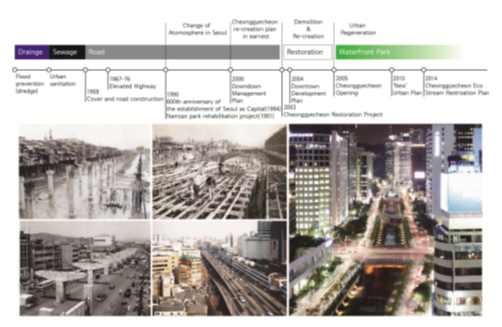
■ การสร้างจินตภาพอย่างสร้างสรรค์
"การสร้างจินตภาพ" เป็นคำสำคัญในการบูรณะคลองชองกเยชอน การทุบทำลายถนน 18 เลน บริเวณใจกลางกรุงโซลที่มีการจราจรคับคั่ง ท่ามกลางรถยนต์ที่เพิ่มจำนวนขึ้นเรื่อย ๆ และปัญหาการจราจรติดขัดที่กำลังขยายวงกว้าง เป็นสิ่งที่เหนือความคาดหมาย ประชาชนจำนวนมากเกรงว่าจะประสบปัญหาการจราจรอย่างหนักจึงต่อต้านแผนการดำเนินโครงการอย่างรุนแรง อย่างไรก็ตาม การทุบทำลายถนนและการสร้างพื้นที่ริมน้ำทำให้สภาพแวดล้อมย่านใจกลางเมืองดีขึ้นและมีชีวิตชีวามากขึ้น เกิดการพัฒนาคุณภาพชีวิตประชาชน ส่งผลให้การรับรู้เกี่ยวกับพื้นที่สาธารณะเปลี่ยนแปลงไป ระบบการคมนาคมมีการเปลี่ยนแปลงอย่างรวดเร็วโดยผู้คนเปลี่ยนไปใช้ระบบขนส่งสาธารณะมากขึ้น ส่งผลให้สภาพการจราจรย่านใจกลางเมืองดีขึ้น
ซึ่งตรงข้ามกับการคาดการณ์ของผู้เชี่ยวชาญหลายท่าน
■ ภาวะผู้นำ
ภาวะผู้นำมีความสำคัญในการเปลี่ยนแปลงครั้งประวัติศาสตร์นี้มาก ผู้นำควรแสดงวิสัยทัศน์ที่ชัดเจนได้ บริหารหน่วยงานและทรัพยากรบุคคลอย่างมีประสิทธิภาพ ตอบข้อสงสัยภายในหน่วยงาน แก้ปัญหาภายนอกหน่วยงาน และสื่อสารโน้มน้าวจิตใจประชาชน ภาวะผู้นำเช่นนี้จะสามารถทำให้เกิดการเปลี่ยนแปลงภายในเมืองได้ โดยเฉพาะอย่างยิ่ง บทบาทผู้นำเป็นส่วนสำคัญในการนำองค์กรของเจ้าหน้าที่รัฐอย่างมีประสิทธิภาพ สามารถป้องกันความไม่ลงรอยกันที่อาจเกิดขึ้นโดยการปรึกษาหารือกันอย่างสม่ำเสมอ รวมถึงเปลี่ยนแปลงทิศทางองค์กรให้มุ่งเน้นไปที่การทำงานในสถานที่จริงเพื่อความมีประสิทธิภาพ และเจรจาต่อรองกับผู้มีส่วนได้ส่วนเสียเพื่อให้มีความคิดเห็นไปในทิศทางเดียวกัน
■ ระบบการดำเนินงานที่เหมาะสมและการจัดการโครงการอย่างมีประสิทธิภาพ
ในระหว่างการดำเนินโครงการระยะแรก คณะกรรมการประชาชนซึ่งประกอบด้วยประชาชนทั่วไปและผู้เชี่ยวชาญได้รวบรวมความคิดเห็นอันหลากหลายและสร้างฉันทามติที่มีส่วนในการกำหนดทิศทางโครงการอย่างมาก การบูรณะจะไม่สำเร็จหากดำเนินการเพียงไม่กี่ฝ่าย ความร่วมมือระหว่างส่วนงานต่าง ๆ
ทั้งด้านน้ำ ถนน การระบายน้ำ วิศวกรรมโยธา การตกแต่งสวน สถาปัตยกรรม การวางผังเมือง เศรษฐศาสตร์ กิจการสังคม และสวัสดิการ มีความสำคัญต่อการดำเนินโครงการ กรุงโซลจึงควรมอบหมายเจ้าหน้าที่ระดับรองนายกเทศมนตรีเป็นผู้รับผิดชอบบริหารจัดการและประสานงานโครงการอย่างมีประสิทธิภาพ นอกจากนี้
การประชุมประจำสัปดาห์ทุกวันเสาร์เวลา 08.00 น. เป็นส่วนสำคัญในการตัดสินใจอย่างรวดเร็วและการแก้ปัญหาความไม่ลงตัวระหว่างหน่วยงานต่าง ๆ โดยไม่ต้องใช้งบประมาณเกินกว่าที่กำหนดมากนัก
■ การร่วมลงทุนระหว่างภาครัฐและภาคเอกชน และระบบการดำเนินงานแบบสามเหลี่ยม
การร่วมลงทุนระหว่างภาครัฐและภาคเอกชนอย่างใกล้ชิดนำไปสู่การพลิกโฉมย่านใจกลางเมือง ด้วยเหตุนี้ ระบบการดำเนินงานแบบสามเหลี่ยม (Triangular implementation system)
ซึ่งประกอบด้วยภาครัฐที่เป็นผู้ดำเนินโครงการ การวิจัยที่ให้ความรู้ความเชี่ยวชาญ และคณะกรรมการประชาชนที่รวบรวมความคิดเห็นของประชาชน เป็นไปอย่างมีประสิทธิภาพ แนวปฏิบัตินี้นำไปสู่การวางแผนร่วมกันในการวางผังเมืองของกรุงโซล
■ ข้อดีและข้อเสียของกระบวนการทําให้เป็นการเมือง
การบูรณะคลองชองกเยชอนได้ผ่านกระบวนการทําให้เป็นการเมือง (Politicalization) ซึ่งถือเป็นดาบสองคม ถึงแม้ว่าการเมืองจะเป็นกำลังสำคัญในการผลักดันโครงการ แต่กลับทำให้โครงการกลายเป็นประเด็นวิพากษ์วิจารณ์ทางการเมืองแทนที่จะเป็นเหตุผลสนับสนุนการฟื้นฟูเมือง นอกจากนี้ยังกลายเป็นประเด็นเพื่อการแข่งขันระหว่างการเลือกตั้งนายกเทศมนตรีในทุก ๆ 4 ปี การดำเนินโครงการจะต้องมีการบริหารจัดการในระยะยาว แต่ประชาชนยังไม่เชื่อมั่นว่าจะสามารถดำเนินโครงการบูรณะคลองชองกเยชอนและทำการฟื้นฟูเมืองได้อย่างต่อเนื่อง เป็นที่น่าเสียดายว่ารัฐไม่มีบทบาทในการฟื้นฟูเมือง หน้าที่ดังกล่าวจึงตกอยู่กับภาคประชาชนเพียงฝ่ายเดียว
การชุบชีวิตคลองชองกเยชอน: ก้าวใหม่สู่อนาคตของกรุงโซล
โครงการบูรณะคลองชองกเยชอนระยะแรกเสร็จสิ้นเมื่อ ค.ศ. 2005 แม้จะถูกมองว่าเป็นการทำงานอย่างเร่งรีบ แต่เป็นที่น่าสนใจว่ากรุงโซลสามารถกำหนดขอบเขตการดำเนินงานในบริเวณใจกลางเมืองที่มีความสลับซับซ้อนได้อย่างมีประสิทธิภาพและดำเนินการได้ในระยะเวลาอันสั้น อีกทั้งสามารถลดความไม่สะดวกที่เกิดขึ้นได้ คลองชองกเยชอนมีสภาพก่อนการบูรณะที่เสื่อมโทรมและเต็มไปด้วยมลพิษ ก่อนหน้านี้เคยมีแนวคิดที่จะเปลี่ยนแปลงคลองชองกเยชอนเกิดขึ้นประปราย แต่ยังไม่มีการกำหนดแผนปฏิบัติการอย่างจริงจังเนื่องจากสถานที่แห่งนี้เคยเป็นถนนมากว่า 50 ปี ผู้คนจึงมองว่าคลองชองกเยชอนเป็นสถานที่สำหรับรถยนต์ การสร้างจินตภาพจากคลองในขณะนั้นให้เป็นสถานที่ที่มีธรรมชาติและสายน้ำ อีกทั้งสามารถทำให้เกิดขึ้นจริงจึงต้องอาศัยการคิดนอกกรอบอย่างแท้จริง
โครงการบูรณะคลองชองกเยชอนกลายเป็นจุดเปลี่ยนของทิศทางการพัฒนากรุงโซลด้วยการแทนที่รถยนต์และสิ่งก่อสร้างต่าง ๆ ด้วยธรรมชาติ รวมถึงการสร้างภูมิทัศน์ในเมืองที่เอื้อต่อผู้คน พร้อมด้วยการเพิ่มคุณค่าและอัตลักษณ์ทางประวัติศาสตร์ นอกจากนี้ยังก่อให้เกิดการเปลี่ยนแปลงจิตสำนึกของประชาชนครั้งใหญ่
ในกรณีการบูรณะสิ่งก่อสร้างทางประวัติศาสตร์บางแห่งที่ก่อให้เกิดกระแสพากษ์วิจารณ์ กรุงโซลได้มีการดำเนินการที่เหมาะสมโดยแบ่งการบูรณะออกเป็นระยะแทนการดำเนินการในคราวเดียว สภาพของย่านใจกลางเมืองที่มีความซับซ้อนส่งผลให้ต้องดำเนินการโดยอาศัยต้นทุนทางสังคมสูง อย่างไรก็ตาม เป็นที่น่าเสียดายว่ากรุงโซลไม่สามารถสร้างฉันทามติในประเด็นดังกล่าวให้เกิดขึ้นได้
คลองชองกเยชอนโฉมใหม่นี้ไม่ได้เป็นเพียงแค่การบูรณะ แต่เป็นการสร้างขึ้นใหม่ กล่าวคือเป็นการทุบทำลายทางยกระดับเพื่อสร้างลำคลองที่เป็นมิตรต่อสิ่งแวดล้อมและเอื้อต่อผู้คนที่เดินสัญจรไปมา โครงการนี้ยังครอบคลุมถึงการก่อสร้างระบบบำบัดน้ำเสียและป้องกันน้ำท่วม ชาวกรุงโซลหลายแสนคนในอดีตต้องพึ่งพาน้ำที่ผ่านกลไกการกรองตามธรรมชาติจากลำคลอง แต่โครงการนี้ได้เปลี่ยนคลองชองกเยชอนให้เป็นพื้นที่สาธารณะในย่านใจกลางเมืองที่เป็นมิตรต่อผู้คนและสิ่งแวดล้อม มีคุณค่าทางประวัติศาสตร์ และมีศักยภาพในการเติบโตในอนาคต การพลิกโฉมพื้นที่สาธารณะแห่งนี้ถือเป็นการจุดประกายให้เกิดการฟื้นฟูพื้นที่ย่านใจกลางเมืองอย่างต่อเนื่องจนถึงปัจจุบัน
Seoul Urban Regeneration:
Cheonggyecheon Restoration and Downtown Revitalization

Photo credit: visitseoul.net
- Issues and Paradigm Shift
Decline in the downtown of Seoul
The downtown of Seoul, including the area around the stream of Cheonggyecheon, was the center of urban economy filled with many businesses. The road covering Cheonggyecheon and the elevated highway were the artery of urban transportation. The downtown was truly a place that led the urban economic development by generating new jobs and spurring creative activities and innovations. From the 1980s, however, Seoul’s economic structure changed from small-scale light industries to manufacturing and services. The downtown was composed of too small plots and narrow roads to accommodate the new industries. Development was not easy because of the land prices that were already too high. As development and redevelopment stagnated, the old downtown became increasingly obsolete. As the land prices didn't fall whatsoever while the landscape was worn out and the quality of life deteriorated, people and businesses left the downtown area. The urban structure also changed. In the past, the downtown had been the center of everything―residence, work, production, etc.―, but it became a central business district that focused more on production and businesses in the course of urbanization. Residential area moved to the suburban area since it was more comfortable, quiet, clean and appropriate to educate children. Seoul's urban structure kept changing through multi-centralization with growing sub-centers and competition among different land uses. As the old downtown failed to adapt to the change, people and businesses began to turn away from it.
In 2000, the number of businesses within the downtown was 77,000, down 24.1% from 100,200 in 1991. Given that the number of businesses in the entire Seoul jumped by 24.6% during the same period, the 24.1% decline was enormous. The share of downtown businesses in the overall number of businesses in Seoul also declined to 10.8% in 2000, from 17.7% in 1991. The number of downtown workers in 2000 marked 400,000, 54.3% decline since 1991. Their share in the overall Seoul also fell from 18.9% in 1991 to 11.7% in 2000.


Before & After. Photo credit: Dr. In-Keun LEE
Safety issue of the elevated highway
It was the safety issue that triggered discussions on the restoration of Cheonggyecheon. The structure of covering road and the elevated highway was deteriorated, causing serious safety risk since the 1990s. As an in-depth investigation conducted by the Korean Society of Civil Engineers in 1991-92 found the corrosion of the steel frame inside the highway and structural flaws in its upper plate, a thorough repair work was conducted for a 2-kilometer sector of it. The 30-year-old road covering Cheonggyecheon costed substantial amount of money for continuing maintenance and repair. Another in-depth safety checkup conducted from August 2000 to May 2001 revealed that cracks and exfoliation persisted in the upper slab, while the load carrying capacity was insufficient due to the worn-out concrete beams. As a result, a full-scale reconstruction was inevitable. Reconstruction was estimated to cost 93 billion won in three years. In 2001, the city government of Seoul planned to demolish the elevated highway and reconstruct it, beginning from August 2002.
Shift from maintaining the elevated highway to restoring the stream
Since the 1960s, development, construction, production and efficiency have always been priorities in Seoul. Starting from 1990s, however, the urban planning paradigm shifted to focus more on human, history, nature and environment, as the people's consciousness changed over the course of socio-economic development. Discussions on justification, necessity and significance of restoring Cheonggyechon became lively since the late 1990s. The restoration became a major topic during the mayoral election campaign in the first half of 2002. Over the course of political debate, the direction of initial plan shifted from reconstruction of the elevated highway to restoration of the stream. There were still many choices and decisions to make between the idealistic goals―historical values, eco-friendliness, optimization in each sector, etc.―and the practical considerations―cost, time, optimization in the entirety, minimization of inconvenience among the neighboring businesses, phased approach, etc.
- Regeneration of Cheonggyecheon
Framework of urban revitalization by restoration of Cheonggyecheon
Public-driven Cheonggyecheon restoration + Private-driven urban revitalization
The aim of the project was to restore a decrepit public space to create a waterfront in the downtown, improve the environment and restore the historical value. Such an attempt would revitalize the city by attracting more population and more business activities, which would eventually enhance growth momentum and attract more private investment. At the same time, the discussions included the measure through which the private and public sectors could share the benefit, while achieving urban revitalization led by the private sector. Along with setting the long-term goal, determining specific project boundary was another challenge. While Cheonggyecheon itself was a public place, the surrounding area was privately held properties. To include the private properties in the project would not only cause the project budget to snowball, but cost enormous time to deal with administrative matters such as revision of urban plans and compensation. Therefore, the Seoul municipality decided that the restoration work itself would exclusively cover the public land within Cheonggyero to ensure the feasibility of the project. In this approach, the public and private sectors had to take their respective role in turn. Firstly, the city government was to demolish the coverage and the elevated highway, create an eco-friendly waterfront and restore the historical value of the stream through public investment. The ripple effect of restoration would help revitalization of the downtown and the neighboring area, which will be conducted in partnership with the private sector in a way that both public and private sectors could benefit.

Restoring Cheonggyecheon, restoring natural values of aquatic ecosystem of Seoul
Cheonggyecheon is a long stream that flows across the downtown. It also has many tributaries. By restoring its tributaries such as Junghakcheon and Baekundongcheon in the upstream, the city had a long-term plan to rehabilitate the aquatic ecosystem of Seoul. But this could not be implemented at once. Therefore, the project boundary was designated between Sejongno and the stream's confluence point with Jungnangcheon.

Controversies in the course of specific plan development
Although people agreed on the necessity of Cheonggyecheon restoration, they had different opinions about what the restored stream should look alike. Some prioritized the historical values while others wanted to minimize the contruction-related inconvenience in the vicinity. Transportation and flood prevention were also big issues to consider, as were the practical issues such as construction period and cost. In addition, further decision had to be made on the budget, phasing of implementation, project boundary, water supply and technical level of construction. There was a great deal of conflicts in the planning stage due to contradictions among many different factors to consider. The city therefore organized the citizens' commission to collect diverse opinions of citizens, experts and stakeholders, and reflected them in the master plan. Given that it was a long-term project in nature, it was important to set a long-term direction. However, the city needed to conclude an optimal solution at that specific point to move forward. After a series of discussions, the Cheonggyecheon restoration master plan was completed in June 2003. Even after that, discussion to fine-tune the project and develop a longer-term initiative continued.
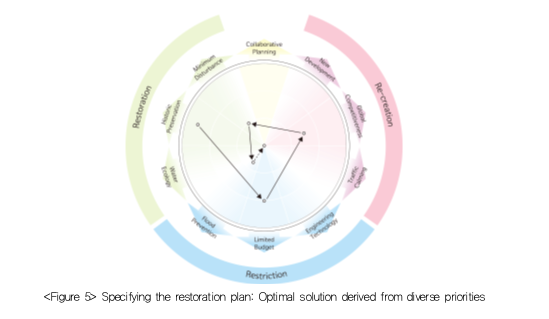
Major components of Cheonggyecheon restoration plan
The restoration had to consider diverse factors of Cheonggyecheon in the historical, structural and functional aspects. Restoration of historical remains such as old bridges and stoneworks at the stream was one of the main concerns by citizens. The restored stream also needed to have enough capacity to deal with floods, as abnormal rain fall became more frequent due to climate change. In addition, it was necessary to maintain its previous role for transportation and sewage. Most of all, the project had to create a better natural environment, which was the biggest aspiration of the citizens. To this end, it was imperative to secure water supply for the stream, which turned out a difficult task.
■ Restoration of historical values
Restoration of historical values was important in justifying the project and ensuring citizens' support. With this recognition, the Seoul municipality set it a principle to preserve all the heritage excavated during the construction. In the actual work, however, the safety of citizens emerged as a bigger priority. The municipality's principle was to restore the originality to the extent in which citizens' safety from flood and other risks is ensured. However, some members of the citizens' committee and some civil associations insisted that the stream be restored entirely in its originality. Such a difference sharpened in the phase of actual work. As specific concerns emerged with regard to flood control, transportation and negotiations with the neighbor businesses, some of them became incompatible with the preservation of historical remains.One of the biggest issues was the restoration of Gwangtonggyo bridge. There was a strong argument to restore it to its original shape, which required an extensive work. In order to secure enough cross-sectional area for the water flow, in other words discharge area, it was necessary to purchase private lands in the bridge's vicinity, but it was practically impossible. Insufficient area for discharge would lead to failure in safety and flood control. The city finally decided to rebuild Gwangtonggyo at a spot 150m away from the original location to the upstream, in a belief that restoration at the original location will be possible in the future when a better condition is prepared.
<Table 5> Comparison of arguments about restoration of Gwangtonggyo
|
Current status
|
Restoration in its originality
|
Alternative
|
|
- 12m-long, 16m-wide
- Currently under the coverage (See figure 15)
|
- Discharge area insufficient (flood risk)
- Additional modification necessary to too short bridge posts for flood prevention
- Maintenance of original shape difficult due to exposure to sunlight, vibration from vehicles, air pollution and flood risk
- Namdaemunno inevitably needed to be cut by half (from 8 to 4 lanes)
|
- Location altered to use as a pedestrian bridge
- Original shape preserved with partial modification
- Flood risk avoidable by discharge area design
- No need to halve Namdaemunno lanes
※ Restoration in the original shape and location would be possible in a better condition in the future
|
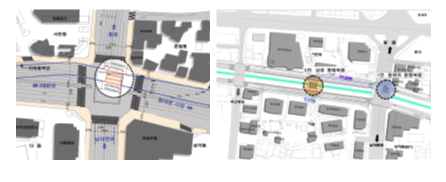
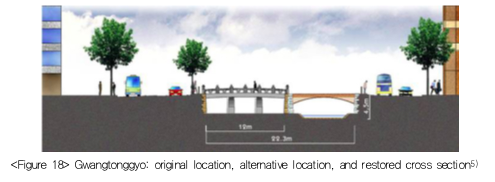
Restoration of Supyogyo in its originality might incur similar problems. The Cultural Heritage Committee of Seoul concluded to leave Supyogyo where it was, in the Jangchungdan Park, in order to avoid deterioration of the original stones. At 27.5m, the original Supyogyo was longer than the width of the restored stream (22m) at the point. To restore it in the original shape, the city had to expropriate private properties in the vicinity, which would inevitably prolong the construction and cause more inconvenience for the neighboring businesses. Therefore, the municipality decided to restore Supyogyo in the future, once favorable conditions are made available.
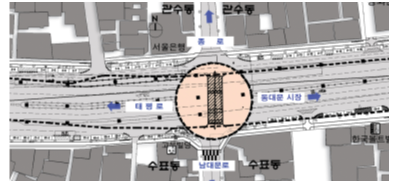

■ Flood prevention and safety measures
Although the restoration of Cheonggyecheon was initiated in a bid to restore historical and environmental values, the safety issues including flood prevention came to the fore in the course materialization. The city set the target flood recurrence interval of 200 years. Given that other 2nd-grade local streams were managed based on 50-year interval assumption, it was a decision to better ensure the citizens' safety by securing sufficient stream capacity to deal with local torrential rainfalls. The city also strived to secure discharge area by excavating the underneath of both banks.

■ Sewerage treatment
Substantial number of sewerage pipes were buried near Cheonggyecheon, since sewage water of the downtown Seoul was traditionally gathered along it. Finding ways to treat such sewage was a precondition to the restoration. Since the existing sewerage system was often combined with rainwater collection system before it reached the stream, it was practically impossible to segregate sewage from rainwater. Separation between them was also inappropriate because the downtown rainwater flowing into Cheonggyecheon was highly polluted. Therefore, the municipality adopted a double-box system. The sewage would be treated in a combined system, but highly-polluted initial rainfall would be segregated into a separate pipeline to be treated at the treatment facilities, not flowing into the stream.

■ Water supply and its quality
Cheonggyecheon was historically a ephemeral stream. It was difficult to draw water from the vicinity, because underground water level became lower due to urbanization. Given that there was no valley water from the upstream, artificial supply of water was inevitable to maintain the stream. The Hangang (Han River) and the groundwater discharged from nearby subway stations were selected as water sources. The Korea Water Resources Corporation attempted to tax the Seoul municipality for drawing water from Hangang, but it was eventually discounted by 100% on the ground that the water would be used for the public interest. As for the water quality, the water treatment was decided as secondary treatment considering relevant conditions and costs.
Overcoming technical difficulties - Short construction period, limited budget, and waste recycling
As announced in 2001, Cheonggyecheon was planned to be demolished and renovated in three years from 2002, during which inconvenience of neighboring merchants was inevitable. Since the main complaint of neighboring merchants was to minimize construction period, it became a priority to complete the work as soon as possible. In order to shorten the construction period and accommodate a diversity of creative ideas from the private sector, the contract for the project was processed in the "fast-track design-build" system. Among the companies participated in the bidding process, based on the basic design guidelines developed by the city government of Seoul, contractors were selected. Since three different entities designed each zone separately, the city government intervened to ensure consistency and solve the problems such as concept differences or errors in sewage pipeline's connectivity between each zone. The construction started in July 2003, and major structures were demolished by October. During demolition, the detailed design for construction works in the stream was developed simultaneously, and the construction was completed in the early 2005. After a series of test-run during the rainy season, the project was completed by September 2005, taking 27 months in total. 96% of waste generated during the construction was recycled.
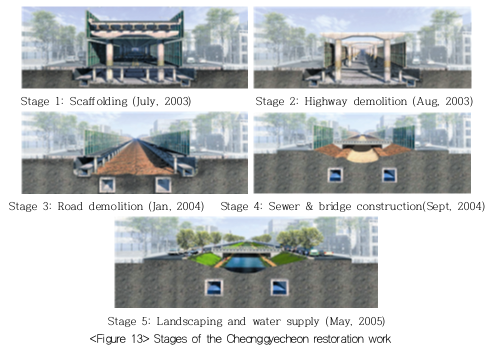
- Revitalization of the downtown area
In order to revitalize the downtown area, utilizing the development potential which increased through the Cheonggyecheon restoration, the existing urban plans needed some modification. In this context, the "Downtown Management Plan" devised in 2000 was revised and renamed into a "Downtown Development Plan," adopting more active nuance by changing the word.
Downtown revitalization plan
Along with the restoration efforts, the Seoul municipality set it a goal to refrain from excessive development and create places for cultural experience, businesses, shopping and tourist activities around Cheonggyecheon, with an aim to maintain economic vitality of the area. It created tourist programs to allow participants to look around historical and cultural heritage around Cheonggyecheon and developed an urban management plan to regulate building height, building coverage ratio, development density and parking standards. The Downtown Development Plan in 2004 divided the area around Cheonggyecheon into 22 blocks and categorized them into special feature preservation zone, redevelopment zone, voluntary renewal zone and comprehensive reorganization zone in accordance with their characteristics, land use pattern and historical features. Among them, the redevelopment zones and comprehensive improvement zones were intended to be developed actively to strengthen their characteristics. On the other hand, preservation and voluntary renewal zones were to preserve their identities, while adapting to the circumstantial changes.
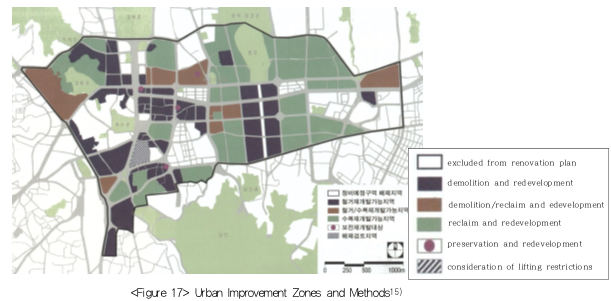
For example, in Gwancheol-dong, designated as a preservation zone, large-scale development was limited by imposing maximum plot area for co-development to protect its spatial identity, while commercial usage for street revitalization in the lower stories of buildings was encouraged to create a pedestrian-oriented environment. (See figure 12)
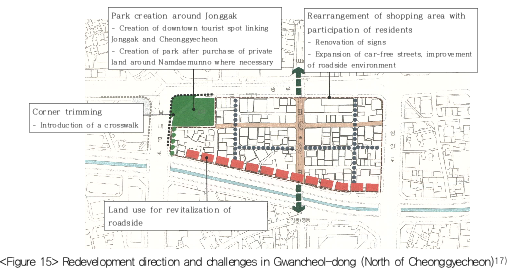
In Samgak-dong, designated as a redevelopment zone, a group of small buildings were merged and redeveloped into a large building to provide public space for the citizens along the stream. However, historical buildings and the traces of Cheonggyecheon tributary were preserved.

Ensuring public goods in the vicinity
In the aspect of revitalization, the biggest problem of land use pattern around Cheonggyecheon was an absolute lack of green space and public space for the citizens to walk around and rest, other than Cheonggyecheon road. The elevation difference between the ground level and the stream were considerable because of the flood control. Also, the stream was too narrow to create a gradual slope to connect it to the ground level. Moreover, bigger width needed to be secured to make Cheonggyecheon a more naturally-looking curved stream in the longer term. To ensure sufficient width, the city had to buy the land from the owners of private properties in the vicinity, but purchasing neighboring properties would be an extremely time- and money-consuming process. Another way to prevent losses in the private sector and ensure public space was to secure public land through negotiation. When the private owners hand over a part of the land for public usage, the public gave them incentives to allow the building developed higher. Physically speaking, the municipality horizontally secured public space while allowing more developments vertically.
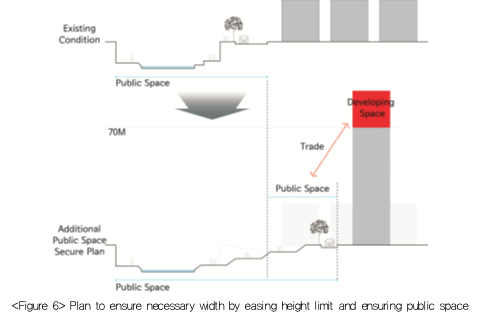
Easing the height regulations might undermine the effort to control the downtown skyline, but it was a practical way for the city to secure public space by compensating the private sector's losses. Purchase was practically almost impossible due to enormous financial burden, prolonged administrative processes and complicated interests of many small plot owners. In such a context, the height regulation in the vicinity of Cheonggyecheon was eased. Looking at height regulation of the downtown plan, many 50 meter limit zones in the 2000 plan became the 70 meter zones in the 2004 plan.
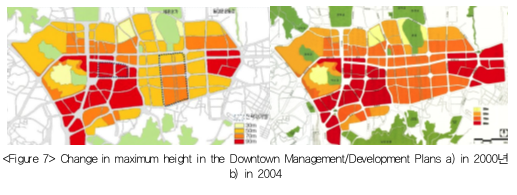
- Achievements
Improvement of environment: Creation of wind corridor, reduction of heat island effect, better air quality, and restoration of natural environment
Physical change and reduced traffic volume in the Cheonggyecheon area reportedly reduced the concentration of fine dust (PM-10), NO2, volatile organic compound (VOC) and other air pollutant in a significant level, shorty after the restoration. The heat island effect in the downtown also declined. The temperature of the Cheonggyecheon area before the restoration was 2.2℃ higher than the average of Seoul, but it declined to 1.3℃ after the restoration, dropping by 8 to 18%. The temperature of green point within the stream was 0.9℃ lower than neighboring area, As air-blocking elevated highway disappeared, wind corridor was established and the creation of stream affected neighboring environment. Ecosystem was also restored as wildlife fish species, birds, insects and plants increased.
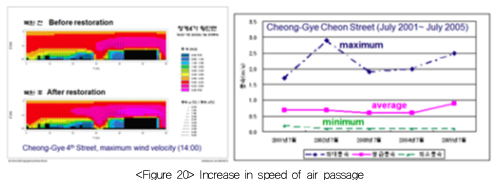
|
|
2003
|
2004
|
2005-2006
|
2010
|
2011-2012
|
|
Plant
|
121
|
136
|
160
|
510
|
365
|
|
Wildlife animals
|
9
|
18
|
19
|
37
|
48
|
|
Insects
|
70
|
94
|
113
|
248
|
112
|
|
Fish
|
7
|
7
|
21
|
25
|
23
|
|
Benthic invertebrate
|
28
|
28
|
27
|
29
|
44
|
|
Source
|
Ministry of Science and Technology (2007)
|
Seoul Metropolitan Facilities Management Corporation (2010)
|
Seoul Metropolitan Government (2012)
|
|
|
Flood control
Cheonggyecheon is the lowest-lying area in the old downtown with an extensive basin to collect rainwater and gently sloped banks, which make it a highly flooding-prone stream. Overflow occurred for two consecutive years before the restoration began, causing damage in the downtown area. Given that local torrential rainfall is frequent in Seoul, discharge area of the restored stream was designed on the basis of 200-year recurrence interval. While the estimation at 200-year recurrence interval had revealed that most of the low-lying area around Cheonggyecheon had been subject to inundation before the restoration, there was no report of flooding due to lack of discharge area after the restoration, which means that the vicinity was made free from flooding damage.
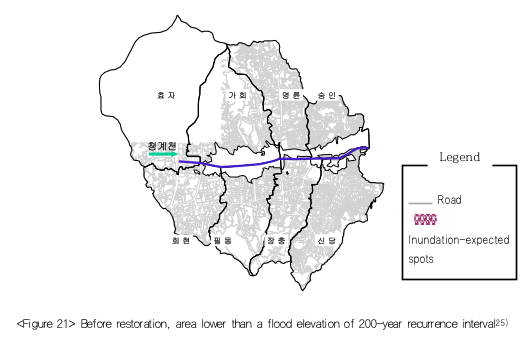
Increased public space, pedestrian-friendly environment, more floating population and tourists
The floating population in the Cheonggyecheon area of weekdays and weekend recorded a significant increase. The increase was larger in weekdays than in weekends, meaning that citizens visit the stream often in their daily lives. In the 2013 survey, 89% of respondents were on the fence or satisfied with the walking trail along the stream. They were particularly satisfied with the uniqueness of the place itself. However, they showed lower level of satisfaction in accessibility, because the access from the ground level to the stream was limited due to the stream's narrow width. From the perspective of citizens, the biggest contribution of the restoration was the creation of a place to relax. In the 2013 survey, 59.6% of respondents indicated so. Cheonggyecheon also became a venue for diverse cultural events: 259 events were hosted in 2005-07, firmly positioning the stream as a place for culture and recreation.
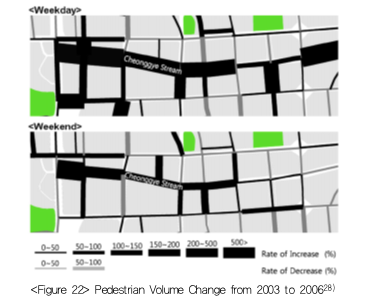
With the restoration of Cheonggyecheon, other attractions in the downtown―Gyeongbokgung, Changdeokgung and Myeongdong―were linked through pedestrian roads, enhancing the overall value of the public spaces in the downtown. The downtown of Seoul thus became a more attractive tourist spot. Almost all tour guide books on Seoul include Cheonggyecheon in the recommended itinerary.
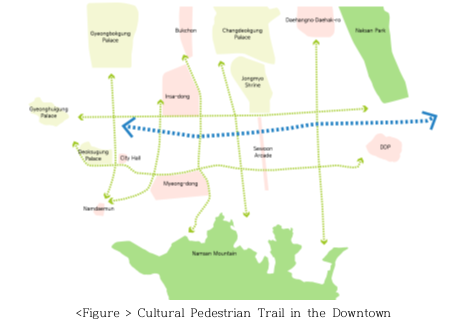
Downtown revitalization, increasing economic activities, and rise of real estate prices
The restored stream enhanced the development potential of the vicinity and accelerated the downtown redevelopment. In the upstream near CBD, the changes in the land use stagnated during the restoration period, but skyrocketed since 2006 after the restoration was finished. 74.4% of land use changes were for commerce or office purposes, which shows that development for such purposes increased in the CBD area. In particular, many large-scale building were developed after the restoration.
Changes in citizens' consciousness
One of the big achievement of the Cheonggyecheon restoration was the citizens' awareness on the value of natural environment. Even before the restoration project, people already had interests in natural environment and aspiration for a better Cheonggyecheon. After witnessing the restored stream and its environment, people's recognition on the value further increased. According to a survey on citizens' willingness to pay for a natural stream before and after the restoration project, the annual economic value of a natural stream appreciated by the citizens jumped from KRW 20,226 to 37,724 per household. The survey confirmed that the citizens of Seoul placed a higher value on the natural environment after experiencing the restored Cheonggyecheon.
- Implementation system and finance
Triangular implementation system
The Cheonggyecheon restoration project differs from the past practices in that it created a triangular implementation system, composed of the citizens' committee, the headquarter and the research group. Such a framework was advantageous in efficient project implementation, collection of public opinion, and building public relations.
An official channel to collect various opinions of citizens was necessary to push forward the project efficiently. The Cheonggyecheon Citizens' Committee was established for that purposes. Experts of the Cheonggyecheon Revival Research Group joined the committee, along with other experts and citizen representatives of various backgrounds. The committee's primary role was to set the directions of the restoration project. It was given rights to audit and monitor as well as to simply advise on the project. The committee also had legally-binding rights by enacting ordinances. In addition to deliberation and assessment, the committee conducted a series of hearings and briefings to garner various public opinions, build a public consensus and encourage citizens to participate in the project.
The headquarter office that actually implement the project was also necessary. It launched in July 2nd, 2002, and initially consisted of three departments: each on to manage, plan and implement the project. The organization was modified continually to adapt to the evolving stage of the work. Focusing strictly on the actual works on the site, the headquarter was established in the City Hall to ensure efficient communication and project implementation. It conducted a weekly meeting hosted by the mayor every Saturday to maximize the efficiency. All the highest-responsible persons attended the meeting to discuss the major issues of the project and made decisions in a speedy and determined manner. The Saturday meeting thus contributed to resolving potential conflicts within the municipality and ensuring consistency of the work.
Cheonggyecheon Research Group was established temporarily under the Seoul Development Institute (renamed afterwards as Seoul Institute) to support the restoration project. Its assignment was to conduct research projects on the basic data and blueprint for the Cheonggyecheon restoration. It contributed to the project by researching on most of issues related to the restoration, such as transportation, land use, urban planning, environment and culture. It also organized a variety of seminars and meetings with outside experts for advices, and conducted a variety of activities to promote the restoration through academic events, public relations, and addressing media outlets.
Financing
Budget estimation and its financing were important issues in the project. As the city aimed to have the project recognized as a public one and secure the government budget, it was important to get the approval from the Seoul Metropolitan Council. To secure the budget of KRW 384 billion for the restoration, the municipality utilized KRW 100 billion that was initially assigned for the overall renovation of Cheonggye elevated highway. It also saved some KRW 100.4 billion by downsizing less urgent projects and introducing creative work procedures to enhance efficiency of the city administration. The rest of the budget was secured from the city's general accounting. Further, donations were made on some bridge. The project fund for Samilgyo, Mojeongyo, Gwangtonggyo and Jangtonggyo was donated, allowing the municipality to save KRW 8.2 from the budget. In total, KRW 384.4 was invested in the project. The amount was merely about 1% of the total budget of the Seoul municipality, which was not burdensome at all. Compared to other waterway restoration projects in Korea and abroad, the Cheonggyecheon restoration project was highly economical.
- Challenges to overcome
Opposition from neighboring merchants and street vendors
The strongest opponents to the restoration of Cheonggyecheon were the merchants in the vicinity of the elevated highway. They worried about traffic congestion and negative effects such as noise, dust and other inconvenience during the demolition and construction. The solidarity among over 200,000 merchants was strong as most of them had been there for more than 20 years. They were mostly in a wait-and-see attitude at the initial stage of the project. As the project launched in earnest, however, they started to organize protest groups and held demonstrations. From February to September in 2003, the conflict intensified between the municipality and the merchants, which was sometimes led to violence.
Some 4,200 meetings in various forms were held for negotiations between the city officials and the merchants. The city's strategy was to keep the principle of no direct compensation. The municipality promised to complete the construction work as soon as possible, establish parking lots at the Dongdaemun Stadium and provide free shuttles during the work to minimize the merchants' inconvenience. It also provided financial and administrative support for businesses that wanted to move away and gave them favorable rights to move into a new commercial complex to be created in Munjeongdong area if they wanted. The city also had the street vendors move to the folk market in the Dongdaemun Stadium, and then to a folk market in Sinseol-dong after the stadium was demolished for redevelopment.
Concerns over the traffic chaos
Traffic congestion was one of the primary concerns since the very first stage of the project. Many concerned that eliminating 18 lanes by demolishing the elevated highway and the coverage would generate serious traffic inconveniences. The city government created circular-route buses, increased parking fee to discourage traffic, cracked down on illegal parking, and introduced reversible and one-way lanes to address such concerns. However, these could not be the fundamental solutions to the downtown transportation. The city accelerated its efforts on the transportation reform to change Seoul's transportation to mass-transit-oriented system by increasing capacity of buses and subways. The restoration of Cheonggyecheon triggered the transition to public transit-oriented transportation system. The share of private cars in the total downtown traffic volume decreased from 21% before the restoration to 15% in 2007, while the share of public transport, walking and bike-riding increased.
Flooding and technical issues
Technical issues were also important. In order to shorten the construction period to minimize the inconvenience of the merchants, cutting-edge technologies were adopted to speed up the work. To prevent damage in businesses and maintain traffic on the roads along the stream, the construction had to be conducted inside the stream. Therefore, cutting-edge technologies such as diamond wheel saw were adopted to accelerate the work. Severed materials were loaded on trucks and moved to the outskirt of the city where they were shredded and recycled. An important mission in the construction process was to complete important foundation works between rainy seasons. As Cheonggyecheon had a large basin area, construction tools and materials in the stream were vulnerable to flooding damages. Such an accident actually happened in 2004 and the project was on the verge of serious damage. The construction works had to be completed as shortly as possible, in preparation of floods that came every summer.
Discordance spatial patterns of urban revitalization
When it comes to the redevelopment of the stream's vicinity, controversy have persisted over whether the small plots and lower buildings have to be prioritzed for preservation of the small alleys and the historical values of the downtown, or the larger plots and higher buildings have to be prioritized to provide a public space. As seen in the changing height regulations, the directions to define the identity and usage of the downtown has continued to change. It was therefore important to balance between preservation of the memories of the past and the accommodation of people's new aspiration in the land use. To this end, a detailed redevelopment strategy was necessary to adapt to distinctive land use patterns and identities of each block.
- Lessons Learned
Creative destruction of public space
public space is an important asset in the city. Securing and utilizing it determines the quality and competitiveness of the city. The primary function of Cheonggyecheon in the downtown Seoul has changed over time. During the Joseon dynasty, the main role of Cheonggyecheon in the city of 100,000 population was "drainage" and flood prevention, while the function of "sewage" became important as population grew since the 20th century. After the Korean War, the population of Seoul skyrocketed and an open sewer like Cheonggyecheon became inappropriate due to diseases and odor, while roads became necessary in the process of industrialization. Accordingly, Cheonggyecheon was covered with roads since 1958 and an elevated highway was constructed. Since then until the 2000s, the main function of Cheonggyecheon was 'road,' Today, it is important to create a natural ecological park where people can breathe and relax in the downtown and walk around. As such, the main role of Cheonggyecheon has evolved. However, such a creative destruction of public space to create it anew requires thinking out of the box. Also, new technologies and dedication are essential to make the new ideas into a reality. A public space is not a fixed one. it can evolve.

■ Creative envisioning
"Envisioning" is the most important keyword in the restoration of Cheonggyecheon. Eliminating 18 busiest lanes at the heart of Seoul was certainly something beyond imagination, given that cars were continually increasing, and traffic jams were intensifying. Many people concerned the traffic chaos and strongly opposed the plan. However, the elimination of roads and the creation of a waterfront made the downtown more environmentally pleasant and vibrant. The quality of lives of the people improved, and their awareness on public space also changed. Contrary to the prediction of many experts, the transportation system moved quickly to public transit-oriented, which improved the downtown traffic condition.
■ Leadership
Leadership is crucial in such a ground-breaking transition. A leader should be able to present a clear vision, run the organization and its human resources in an efficient way, resolve the internal skepticism and external conflicts, and communicate and persuade people. Such a leadership actually facilitated the renewal of urban space. In particular, the role of a leader was crucial in leading the organization of public officials effectively, preventing potential cacophonies through constant discussions, altering the organization to focus on the work at the site to ensure efficiency, and persuading different stakeholders to build the consensus.
■ Appropriate implementation system and efficient project management
At the initial stage of the project, the citizens' committee composed of the general public and experts contributed a lot to setting the project's direction by gathering different opinions and building consensus. The restoration could not be achieved with partial approaches. Coordination between different sectors of work―water, road, sewerage, civil engineering, gardening, architecture, urban planning, economics, social affairs and welfare―was crucial to move forward. It was thus appropriate that the municipality appointed a vice-mayor level official to take a responsibility for organizing and coordinating the project effectively. Also, the weekly meeting held at 8am every Saturday played a key role in speedy decision-making and resolution of conflicts between different city departments. As a result, the project could be successfully completed within the target deadline, without exceeding the budget by a large margin.
■ Public-Private partnership, and the triangular implementation system
It is also noteworthy that a close public-private partnership contributed to the downtown transformation. To this end, the triangular implementation system consisting of the administrative agency to implement the project, a research body to provide expertise and a citizens' committee to gather citizens' opinions worked effectively. Such a practice paved the way for the emergence of collaborative planning in the urban planning of Seoul.
■ Pros and cons of politicalization
Politicalization of the Cheonggyecheon restoration was a double-edged sword. While the political momentum certainly drove the restoration project more powerfully, the project became a subject of political controversy, rather than a factor of urban revitalization. It also became a matter of political strife in the mayoral election every four years. Despite the necessity of long-term management, the public sector could not fully ensure the consistency in managing the Cheonggyecheon restoration and urban revitalization efforts. It is unfortunate that the task of urban revitalization exclusively fell to private sector, due to the absence of public intervention.
Rebirth of Cheonggyecheon: A new step forward to the future of Seoul
The first chapter of the Cheonggyecheon restoration finished in 2005. Although some people argue that the project was conducted in an extreme haste, it is remarkable that the project identified practical scope of work in the complicated downtown area and completed it in a short span of time and in an efficient manner that minimized inconvenience. Before the restoration, Cheonggyecheon was a place of deterioration and pollution. There were vague aspirations for change, without specific action plans. Since it had been used as a motorway for 50 years, people perceived Cheonggyecheon as a place for cars. Envisioning a place of nature and waterway in such a condition and realizing it required literally 'thinking-out-of-box' approach. By replacing cars and artificial structures with the nature, creating a human-oriented landscape in the city and equipping the area with historical values and identity, the Cheonggyecheon restoration project became a turning point in shaping the city of Seoul. It also triggered a remarkable shift in citizens' consciousness. When it comes to the controversial issue of the extent to which historical remains be restored, it was appropriate that the municipality took the phased approach rather than restoring everything at once, since that requires excessive social costs in the complicated situation of downtown. However, it is regrettable that the city failed to build enough social consensus on that front. The new Cheonggyecheon was not simply a restoration, but a re-creation. It was basically about demolishing the coverage and elevated highway and creating a pedestrian-oriented and eco-friendly stream. The project also included building infrastructure for sewage treatment and flood prevention. If the Seoul of the past, with some hundreds of thousand people, relied on the self-purification capacity of the stream, the restoration project changed Cheonggyecheon to an eco-friendly, human-friendly public space in the downtown with the historical values and potentials for future growth. Triggered by the re-creation of such a public space, the revitalization of the urban area is still going on today.
https://www.seoulsolution.kr/en/content/seoul-urban-regeneration-cheonggyecheon-restoration-and-downtown-revitalization
เอกสารแนบ : Best Practice - กรุงโซล Cheonggyecheon (ฐิติกร).pdf